

15+ Examples of Descriptive Essays About a Person

Examples of Descriptive Essays About a Person – Descriptive essay is one type of essay that aims to describe a specific object (animal, person, or other thing) specifically. This text type has a slight difference with report text written based on common terms.
The following essays are some examples of descriptive essays about a person, family members, and famous people.
Table of Contents
Essay 1: My Best Friend Laura
Laura J. Bernal, whose nickname is Laura, is my best friend from my childhood. She has a small body and is quite slim. She has oval face with bright brown eyes and thin lips. Laura J. Bernal has long brown straight hair, but she usually makes her hair with horse ponytails. She looks very beautiful, especially when she smiles. She is always cheerful and looks in a good mood. She is a very positive person. We have almost the same hobby of singing. Sometimes our opinions are the same. She is always energetic and brings positive energy for everyone around her. She is like a part of my family. I trust her just as I trust members of my family. She is a very honest type of friend. She always speaks as she is even though it’s bad. Laura always says what she thinks. We are very close to each other. She can even know whether I lie to her or not. I’m very lucky to have a friend like her.
Essay 2: Larry Page
Lawrence “Larry” Page is one of the most influential people in the world. Page is an American computer scientist; he is also an Internet entrepreneur. He was a co-founder of Google with his friend, Sergey Brin, in 1998. Now, he plays a role as a chief executive officer (CEO) of Alphabets, Google’s parent company. Larry Page was born on 26 th March 1973 in Michigan. By 2019, his age is 46 years old. His hair is dark brown while his skin is fair. About his family, a research scientist named Lucinda Southworth is his wife. Now, he is a father of two children.In November 2016, he becomes the 12th richest person. Larry’s last education background is a Ph.D. from Stanford University. Here, he met Sergey Brin. Then, they incorporated Google in order to make world’s information easy to access. This company makes him to be one of the successful people in the world.
Essay 3: My Father
My father’s name is David P. Kent. He is a hardworking man. He works as a government employee. His body is tall, like my youngest brother. His hair is black and straight, same as mine. He has brown complexion because he likes working under the Sun. I love talking to my father. He is a wise man who always gives me great advices. We learn about being a hard-worker from him. We love him very much. He is a great father for us.
Essay 4: Bill Gates
William Henry “Bill” Gates III is one of the richest & influential people. In 1975 together with his friend, Paul Allen, he co-founded Microsoft which became the world’s largest PC software company. That is why his name exists in the list of world’s wealthiest people by Forbes. Bill Gates or Trey as his nickname was born on 28 th October 1955 in Seattle, Washington, USA. By 2019, he is 64 years old. His hair as well as eye color is same, light brown. Bill Gates’ weight is 64 kg with 5′ 9″ height. With his wife named Melinda Gates, they have three children. Besides being the best-known entrepreneur, Bill Gates is also known as a philanthropist. In 2000, he & his wife created Bill & Melinda Gates Foundation. It was identified as the world’s wealthiest charitable foundation in 2013. Through this foundation, Bill Gates donates large amounts of money to many charitable organizations and scientific research programs.
Essay 5: My Mother
This one is about my mother. Her name is Margaret N. Craft. She has brown complexion and blonde hair. Her height is as same as mine, 5′ 11″. My mother is a tailor. She sews some clothes for women such as shirt, jeans, and skirt. I learn many things about sewing from her. She is a great teacher for me. Every morning, she wakes up earlier than other members in my family. She prepares breakfast for us. She is a tough and patient mother. We love her very much.
Essay 6: Mark Zuckerberg

Mark Elliot Zuckerberg is an American computer programmer & internet entrepreneur. He is a co-founder of Facebook, a famous social media. His name was in the list of 100 wealthiest and most influential people since 2010 by Time Magazine. About his physical appearance, Mark’s body is 170 centimeters tall with 76 kg weight. His hair color is red while his eyes are blue. Mark Zuckerberg was born on 14 th May 1984 in New York, USA. Therefore, he is 35 years old by 2019. Mark Zuckerberg has married to Priscilla Chan; they have one daughter named Maxima Chan Zuckerberg.
Essay 7: My Sister
My sister is four years older than me. Her name is Jennifer P. Todd. I usually call her Jennifer. She has the same hair like my mother, black and quite curly. My sister, mother and I have almost the same body tall. Her height is about 5′ 1″. Just like our father, she is a government employee. She wears glasses for helping her see clearly. She occasionally wears contact lenses. We fought a lot when we were kids. She is a kind sister though and I love her so much.
Essay 8: J. K. Rowling
J. K. Rowling is a British novelist who writes phenomenal fantasy book series of Harry Potter. The books have got worldwide attention. They have become the best selling book series in history. They were sold more than 400 million copies. Joanne Rowling was born on 31 th July 1965 in Yate, Gloucestershire, England. So, she is 54 years old by 2019. About her physical appearance, her height is 5′ 5″, while her weight is 54 kg. She has blonde hair & blue eyes. She’s married two times; she’s got three children. JK. Rowling is a terrific & successful novelist that becomes the richest woman in England. In fact, once she had become unemployed with a destitute life. By writing Harry Potter books which are loaded with spectacular high imagination, she turns to be very famous and wealthy.
Essay 9: My Brother
My brother’s name is Charles O. Joy. I call him Charles. He is the youngest child in my family. He is five years younger than me. I can say that he has fair skin, round brown eyes and small lips. His hair is black and short like our father. He was graduated from English Education Department in University of Pennsylvania a year ago. He loves music very much. He is very good at playing a guitar. Together with his friends, he plays music and creates songs. I believe that he will be a successful artist in the future.
Essay 10: Oprah Winfrey
Oprah Gail Winfrey is a great talk show host from America. Her well-known talk show The Oprah Winfrey Show was the highest-rated television program from 1986 to 2011. Because of this phenomenal talk show, she dubbed as the “Queen of All Media”. She has also been ranked the richest African-American and greatest black philanthropist in American history. Oprah was born on January 29, 1954 in Mississippi, United States. By 2019, her age is 64 years old. She has 5′ 7″ tall while her weight is 77 kg. During her career, she successfully lost her weight. But then, she gained much weight again. She has brown eyes & black hair. Oprah Winfrey was born into poverty in rural Mississippi. She was molested by her cousin, uncle, as well as a family friend when she was nine years old. At 14, she became pregnant but her son was born prematurely and died shortly after birth. Then, she moved to her father’s house and landed a job in radio. Her consistent efforts led her into the successful African-American.
Essay 11: Johnny Depp

Johnny Depp was born on June 9, 1963 in Owensboro, Kentucky, U.S. He is now 54 years old. He started his career on movie in 1984. His first movie is A nightmare on Elm Street and his last movie is Untitled Fantastic Beast Sequel that would be released in 2018. A long his life, he had been an actor in 48 movies. It means that he had been playing more than 40 characters during his life. Thus, seeing his achievement, he is proper to be the winner of the Golden Globe Award and Screen Actors Guild Award for the best actor. Before he became a famous actor, Depp was a musician. The first genre he played was rock music. He is good in playing guitar and writing songs. A long his life, he wrote so many songs for bands, solo vocalist or for movie such as Sweeney Todd.
Essay 12: My Grandmother
I have a grandmother, her name is Mary M. Lewis. I usually called her Granny Mary. Her hair isn’t gray like other grandmothers, but blonde. Her body is quite short, about 5′ 1″. She has brown and bit wrinkly skin. Granny Mary lives in a house with my uncle and aunt. I visit her twice a week. I think she is not that old, because she is 70 years old. However, she still looks fit and strong. She usually goes to the backyard to help my uncle. Sometimes, I go to the backyard with my brother as well and help her pick flowers. We love our grandmother so much.
Essay 13: Taylor Swift
Taylor Alison Swift is an American singer & song writer. She is known for narrative songs about her personal life. Her songs are very popular, namely Shake It Off, Blank Space, Bad Blood. Taylor Swift has appeared as one of the most influential and powerful women by Forbes as well as Time Magazines. By 2019, Taylor Swift’s age is 30 years old. She was born on December 13, 1989 in Reading, Pennsylvania, United States. This beautiful girl has 5′ 10″ tall & weighs 54 kg. Her hair is blonde while her eye color is blue. Her lips are usually red as she likes red color very much. Taylor Swift is a famous wealthy woman but her life was not always so sweet. She suffered bullying in Junior High School. She said that she got dumped by a group of popular girls in the school. They thought that she was weird because she liked country music. This changed after she moved to Nashville; she becomes a successful singer.
Essay 14: My Grandfather
This one is about my grandfather, my father’s dad. His name is Wayne D. Smith. I usually called him “Gran Wayne”. He lived in a house with my uncles and aunties. He has 10 children, including my father. That’s why we have a very big family. Gran Wayne used to jog every morning. When I was just a kid, I loved to wake up early and went to jog with him. After arriving in one small shop, he bought us a milk and an ice cream. We were so happy at that time. We love our grandfather so much.
Essay 15: A Stranger at Every Morning
I see that mysterious person at every morning walking in front of my home in this last two weeks. I never see him before. Perhaps he is a new comer in this village. He always walks slowly with his two big Doberman dogs as he seems like having a total control of his dogs. He is big and tall man with a long hair and full body tattoo on his skin. I think anybody will be afraid of him. He always uses single shirt and shorts and also black sports shoes when he is walking around with his dog. Usually, he is passing in front of my home around 6 in the morning. He always using headset and put his iPhone or something like MP3 players in his pocket shorts.
Essay 16: Vincent van Gogh
Vincent Van Gogh was a Dutch painter that was classified as a post-impressionist painter. He was born on March 30, 1853 in Zundert, Netherlands and died on 29 July in Auvers-sur-Oise, France. At his life time, he was stated as a stupid person who tried and failed to learn painting. Not only that, he was totally poor and suffered. At first, he failed in love and thus made him suffered in life. He failed to be anything like normal people. His failure in love broke his mental and confidence. Before he became a painter, or let say liked painting, he was a protestant missionary in Southern Belgium. His duty was in the coal mine and there he saw the truth about suffering and the truth about his own God. Seeing human suffer he also wanted to experience the same in the name of humanity. He lost his faith and started to paint. Traveling from one place to another, Van Gogh lived in poverty. His life was spent to paint even people said that his art work was a bad art. He also suffered from psychotic and delusion. At the last time of his life, he was at the mental hospital, Auvers-sur-Oise, France. He was depressed and finally shot himself and died two days after that. After his death and the popularity of the discourse on madness, especially the knowledge of the psychotic, his painting became popular and categorized as a high art of post-impressionist painting. Unfortunately, Van Gogh never knew that the prices of his painting are now billions.
These are the 15+ examples of descriptive essays about a person. If you’re looking for descriptive essay ideas about family members, friends, or famous people (such as CEO, writers, or celebrity), then you were coming to the right place.
We hope this helps and thanks for reading!
Share this:
- Click to share on Twitter (Opens in new window)
- Click to share on Facebook (Opens in new window)
- Click to share on Tumblr (Opens in new window)
- Click to share on Pinterest (Opens in new window)
- Click to share on WhatsApp (Opens in new window)
One thought on “ 15+ Examples of Descriptive Essays About a Person ”
i want to describe me.
Leave a Reply Cancel reply
Your email address will not be published. Required fields are marked *
Notify me of follow-up comments by email.
Notify me of new posts by email.
- Link to facebook
- Link to linkedin
- Link to twitter
- Link to youtube
- Writing Tips
How to Write a Descriptive Paragraph About a Person (With Examples)
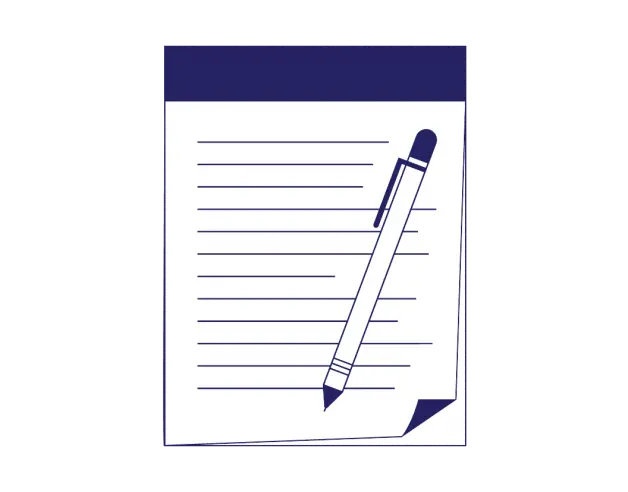
4-minute read
- 7th January 2023
Describing a person or character is difficult for even the most successful authors. It requires a balance of words to make sure they shine through without the language being too heavy. In this article, we’ll look at how to write a descriptive paragraph about a person, share some examples, and talk about different strategies.
1. Brainstorm Your Ideas
Brainstorming is crucial to any writing process. It’s the process in which you think of ideas for what you’d like to write about. In this case, you’re writing a descriptive paragraph about a person. It’s important to use adjectives to describe the features or characteristics you want to focus on.
One way to come up with ideas for a descriptive paragraph about a person is to go through the five senses. Use the questions below to get some ideas for what you want to highlight about your person.
Appeal to your reader’s senses – smell, taste, sound, sight, and touch
Smell: How does the person smell? Do they wear perfume? Are they doing an activity that would make them have a certain smell?
Taste: Do you associate a certain food with this person? Does it make you think of a specific taste? Can you taste something due to a certain smell they have?
Sound: Do they have a unique voice or laugh? Are they doing an activity that has distinctive sounds?
Sight: What prominent features do they have? For example, think about their dressing style, their smile, or their surroundings. What do you see them doing in your mind when you see a photo of them? What memories do you have of this person? Does this person remind you of something or someone?
Touch: What textures do you see? For example, imagine their skin or clothing. How does it feel if you hug them?
2. Begin With a Short and Snappy Sentence
Like with any type of writing, you want to hook your reader so that they want to continue reading. In this case, you can use a topic sentence, if appropriate, to introduce your reader to the person. For example:
Or, if you want to be more creative, you can reel them in with a short and snappy sentence about this person. This is called a writing hook . This sentence should focus on a stand-out detail or characteristic about the person you’re describing. For example:
3. Describe the Person
Now, this is the hard part. But, if you’ve brainstormed plenty of ideas and know which ones you want to focus on, it will be easier. Let’s look at some examples to get a better idea of how to write a descriptive paragraph about a person using the prompt “describe a person you admire.”
Comments: This paragraph is pretty typical of most students. It gives lots of visual details of the person and uses a simile or two (“ Her eyes are like the color of honey” and “Her smile shines like the sun” ). While this strategy gets the job done, it’s not very exciting to read. In fact, it can be quite boring!
Let’s look at how we can rewrite this to make it more exciting.
Find this useful?
Subscribe to our newsletter and get writing tips from our editors straight to your inbox.
Comments: In this example, we focused on one defining characteristic of the person we are describing — her laugh. This strategy places more focus on the person you’re describing, rather than the adjectives you use to describe them.
4. Edit and Revise
After you write your descriptive paragraph, be sure to read it over. Read it out loud. Read it in a funny voice. Doing this will help you to hear the words and identify which parts do not work or sound awkward.
5. General Tips for Descriptive Writing
● Avoid using too many descriptive words.
● Remember to show the reader, not tell.
● Appeal to the reader’s five senses – smell, touch, taste, sight, and sound.
● Focus on a striking or defining characteristic.
● Use contrasting details from other people or surroundings for emphasis.
● Use literary devices (metaphors, similes etc.) sparingly and with intention.
● Use a hook to reel your reader in.
● Use a variety of short and long sentences.
● Practice creative writing exercises to improve your descriptive writing skills.
● Always edit and revise your writing.
If you need more help with writing a descriptive paragraph or essay , send your work to us! Our experts will proofread your first 500 words for free !
Share this article:
Post A New Comment
Got content that needs a quick turnaround? Let us polish your work. Explore our editorial business services.
The benefits of using an online proofreading service.
Proofreading is important to ensure your writing is clear and concise for your readers. Whether...
2-minute read
6 Online AI Presentation Maker Tools
Creating presentations can be time-consuming and frustrating. Trying to construct a visually appealing and informative...
What Is Market Research?
No matter your industry, conducting market research helps you keep up to date with shifting...
8 Press Release Distribution Services for Your Business
In a world where you need to stand out, press releases are key to being...
3-minute read
How to Get a Patent
In the United States, the US Patent and Trademarks Office issues patents. In the United...
The 5 Best Ecommerce Website Design Tools
A visually appealing and user-friendly website is essential for success in today’s competitive ecommerce landscape....

Make sure your writing is the best it can be with our expert English proofreading and editing.
Descriptive Essay
Descriptive Essay Examples
Last updated on: Nov 20, 2023
Descriptive Essay Examples - 8 Examples To Help You Write Better
By: Cathy A.
10 min read
Reviewed By: Rylee W.
Published on: Dec 31, 2019

Do you need some good descriptive essay samples to understand how these essays work? We are here to help you write a descriptive essay with remarkable success!
So stay with us to learn the basics with the help of some great descriptive essay examples.

On this Page
What is a Descriptive Essay?
A descriptive essay describes and gives sensory details about a person, place, event, or thing in an in-depth and detailed manner. It is different from writing a narrative essay.
The aim of descriptive essay writing is to make the reader feel and see a certain thing, place, or person from your perspective. Your readers may have different points of view about the topic, your job is to make them see what you feel and believe.
These types of descriptions are often found in the literature; novels and dramas, where the writer constricts the whole scene through his or her words.
Ever noticed how you feel like actually seeing the character from a novel in your mind? Or a place? This is the power of a descriptive narrative.
What is the Aim of Descriptive Writing?
The sole aim of a descriptive essay writer is to draw a realistic and actual picture in front of the reader. These essays are a part of high school and college level and students.
Teachers give this type of descriptive writing task to students for developing the students’ skills of describing and explaining something in a detailed manner.
This skill is quite helpful in professional life as the students will know how to analyze something in detail and by considering its different angles.
While writing a descriptive essay can be a fun and enriching experience. Describing your emotions and feelings and dealing with a sensitive topic can be a challenging and daunting task. However, with practice, you can do it successfully.
Good Descriptive Essay Examples
It is not an easy task to write a descriptive essay at first attempt. This is why many students turn to the examples of a descriptive essay to understand its structure and content.
Samples and examples are great to help the students understand how to write certain types of essays. Every essay and assignment is different and, therefore, to score well, you need to be mindful of the content that you add to them.
Effective descriptive essay writing is more about describing different aspects and traits of the chosen subject and the type of feelings they inspire. Commonly, these types of essays describe a particular person, an event, a place, or an emotion with the aim to make the reader feel your way.
Descriptive essay example for grade 6
Descriptive essay example college
Descriptive essay example for university
Don’t give up! Continue reading to explore more amazing examples
Descriptive Essay Example about a Person
Writing about a person is probably the first choice of many students. They like to describe their parents, especially siblings, best friends, and teachers in their essays. However, when you choose to write about a person, it is better that you write about someone who you know.
Descriptive Essay Example about a Person (PDF)
Descriptive Essay Example about an Event
As humans, we come across a number of events and happenings. From casual friends get together to very formal weddings and parties, each one of us has something to talk about.
The descriptive essays about events describe the event, how the writer felt about it along the surrounding details.
Just like we say, a descriptive essay ‘describes’ the topic. In the case of descriptive essay examples about an event, the details will include the kind of event, the level of excitement of the writer, the surroundings, and an overall feeling.
Descriptive Essay Example about an Event (PDF)
Descriptive Essay Example About a Place
Describing a place that you visited in your summer holidays is quite an enjoyable experience. It is like you are visiting the same place again and having the same feelings.
When describing your favorite place in an essay, use vivid language. You can describe the details like the weather of the place, the main place that you visited, the kind of feeling you had.
Descriptive Essay Example about a Place (PDF)
Descriptive Essay Example about Emotions
Describing emotions and feelings is difficult.
Memories, emotions, and feelings are abstract and, therefore, explaining them is not easy. They cannot be explained independently, as you can explain a place or event.
A descriptive essay about emotions includes an event and the feelings associated with it. These could be feelings of sadness, anxiousness, confusion, surprise, and happiness.
Whatever emotions you describe, you can use related adjectives and adverbs to describe them.
Descriptive Essay Example about Emotions (PDF)
Descriptive Essay Example About a Visit
A visit to a doctor, a visit to a zoo, and your first visit to a museum, all make excellent descriptive essay topics.
If you go somewhere for the first time, it is natural to have a plethora of feelings and emotions. These could be feelings of joy and even fear.
Descriptive Essay Example about a Visit (PDF)

Paper Due? Why Suffer? That's our Job!
Descriptive Essay Outline
Like every essay sample, a descriptive essay has an outline and format. The essay follows the traditional essay structure and includes:
1. An Introductory Paragraph
The first paragraph of an essay is the introduction and it usually sets the mood for the entire essay.
A good descriptive essay has a strong opening. It introduces the reader to the main topic and what the essay will be about. However, these details are brief and introduce the main topic only.
Some students think that adding more details in this section will add value to their work. Wrong. It will only minimize their chances of expanding the topic in the main paragraphs and leave them with fewer details.
2. Thesis Statement
A thesis statement tells the reader about the thesis question, based on the topic, and the writer’s claim and main argument. It is written after the introduction and before the main paragraphs.
A thesis statement is written at the end of the introduction, it is mainly a single sentence that describes the essay objective.
3. Body Paragraphs
The body paragraphs take more than half of the entire essay and include all the main claims and arguments of the essay. Generally, it has three paragraphs but depends on the topic and its scope. Some topics may not have much to write about while others may have a wide scope and material.
However, if you feel that your topic does not have much room for expansion, do not try to drag it. It will only ruin its essence and overall feel.
4. Conclusion
A solid closing means a solid essay.
Some students think that because it is a closing paragraph, it requires less focus and is less important. But it is not the case. A clumsy conclusion will leave a bad impression and all your hard work may go to waste.
But, a conclusion is also not a place for new ideas. Stay brief and to the point.
To learn more about descriptive essay structure, you can watch this helpful video
Now that you know the basic outline, you can learn how to write a descriptive essay by visiting our blog and working with those tips and tricks.

Create captivating essays effortlessly!
Descriptive Essay Topics
Got inspired by the examples and looking to write your own essay? So select the topic of your choice from the list below and write a tempting essay…
- The street I love to walk around in
- Exploring the beauty of nature
- The pleasing sounds of rain
- The most meaningful experience I had in college
- Exploring a hidden gem in my hometown
- My favorite book character
- A day spent in my dream destination
- Memories of various festivals I have celebrated
- My favorite food that always brings back memories
- These are some
- The beauty of the rising sun in winter
Choosing a Topic for your Essay
Choosing a topic for your descriptive essay can be difficult and challenging. The reason is there are so many things to write about like
- Relationships
- Favorite place
- Experiences
- Things
- Scenarios and many more.
All of these subjects make great descriptive essay topics. Some quick tips to help you choose a great descriptive essay topic include:
- Choose a topic that interests you
- Choose a topic with a good scope
- Choose something that inspires you emotionally
- Choose a topic that appeals to all five or at least one to two senses
- Choose the topic according to your audience
- Choose a topic that is interesting and will keep your readers glued and engaged
For interesting essay topics and ideas, visit our blog and get 100+ descriptive essay topics to choose from.
Tough Essay Due? Hire Tough Writers!
Elements of a Great Descriptive Essay
Great essays are based on elements relevant to the main topic and explain it in detail. Just like other types of essays, descriptive essays are specifically based on describing the main topic. You can do this by using figurative language and words that appeal to the five senses like touch, taste, sight, etc. of the readers.
Some core elements include:
- Choosing a specific subject:
Choosing the right and appealing subject is essential for a good descriptive essay. Research and make a list of the topics that interest you and see which one you could use for your essay. make sure that you know how to work on that topic before finalizing it.
- Select the Details:
You cannot write about everything. No matter how many details there are, you have to choose the most dominant ones and stick to them closely.
- Organize the Details:
Once you have chosen the details and organize them in chronological order. This step is especially important if you are talking about an event because then you have to add details related to the event.
- Use Descriptive Language:
Descriptive and figurative language is a must if you want to draw a clear picture in front of your readers. Adjectives and adverbs, similes and metaphors, and comparisons are some techniques that you could use to compose your descriptive essay.
- Use Appropriate Language:
Relevant language will help you in presenting the information in a coherent and simple manner. The topic of your essay will decide the kind of language that you will use in your essay.
- Do Not Drag the Essay:
Dragging the essay will do no good for your essay. Writing an engaging essay is essential for successful descriptive essay writing. Coherent, relevant, and engaging facts will add credibility and a natural flair to your essay.
Not sure if you could write an impressive and engaging descriptive essay?
5StarEssays.com is here to help you write an essay . With us, you get high-quality, affordable, and timely help. Our quality assurance is rigid and we make sure all the spelling and grammar checking is done before final submission.
Get in touch with us today and order your essay. Or give our AI essay typer a try to get an essay generated within just 90 seconds!
Frequently Asked Questions
How many paragraphs are in a descriptive essay.
Like any other essay, a descriptive essay also must have at least five paragraphs. The number of paragraphs could increase, based on the scope and need of the topic.
How can I write a good descriptive essay?
Writing a good descriptive essay requires vivid and detailed descriptions, creating an experience for the reader. To do this, it’s important to use clear language that creates images in the reader’s mind.
Additionally, using sensory details can help engage the reader and make them feel as if they are partaking in the experience described.
What are some examples of things you could describe in a descriptive essay?
Examples of things you could describe in a descriptive essay include a location, person, object, or event. Each of these should be explored in detail to help the reader form an accurate mental image.

Finance Essay, Education
Cathy has been been working as an author on our platform for over five years now. She has a Masters degree in mass communication and is well-versed in the art of writing. Cathy is a professional who takes her work seriously and is widely appreciated by clients for her excellent writing skills.
Was This Blog Helpful?
Keep reading.
- Interesting Descriptive Essay Topics Recommended by Experts

- How To Write An Impactful Descriptive Essay?

People Also Read
- rhetorical analysis essay writing
- hook examples
- narrative essay outline
- sociology research topics
- types of research
Burdened With Assignments?

Advertisement
- Homework Services: Essay Topics Generator
© 2024 - All rights reserved
How To Write A Descriptive Essay On A Person: Step By Step

- Post author By admin
- March 1, 2024
- No Comments on How To Write A Descriptive Essay On A Person: Step By Step
Descriptive essays are like painting a vivid picture with words. They allow us to delve deep into the essence of someone or something, capturing every detail, emotion, and nuance. When it comes to writing a descriptive essay on a person, it’s all about bringing that individual to life on the page. In this guide, we’ll explore step-by-step how to write a descriptive essay on a person, from choosing the right person to polishing your final draft.
Table of Contents
How Do You Start A Descriptive Essay?
Starting a descriptive essay requires setting the scene and grabbing the reader’s attention. Here are some effective ways to begin:
- Start with a vivid description: Paint a picture with words by describing the setting, person, or object you’ll be focusing on. Use sensory details to immerse the reader in the scene.
- Use an engaging anecdote: Begin with a short story or anecdote related to your subject. This can draw readers in and make them curious to learn more.
- Pose a rhetorical question: Start with a thought-provoking question that relates to your topic. This can pique the reader’s curiosity and encourage them to keep reading for the answer.
- Invoke the senses: Appeal to the reader’s senses by describing sights, sounds, smells, tastes, and textures. This creates a vivid experience for the reader and sets the tone for your essay.
- Provide a brief background: Offer a brief introduction to your subject, providing context for the description that follows. This helps orient the reader and gives them a sense of what to expect.
Ultimately, the goal is to engage the reader from the very beginning and create a strong foundation for your descriptive essay.
How To Write A Descriptive Essay On A Person?
Pre-writing phase.
Before diving into writing, it’s essential to do some groundwork.
- Selecting Your Subject: Choose a person who holds significance for you. It could be a family member, friend, mentor, or even a historical figure you admire.
- Brainstorming Traits: Think about the qualities and characteristics that define this person. Jot down specific details, memories, and anecdotes that come to mind.
- Gathering Memories: Reflect on your experiences with this person. Recall moments that stand out, whether they’re funny, heartwarming, or profound.
- Determining Tone: Consider the tone and perspective you want to convey in your essay. Will it be nostalgic, admiring, or reflective?
Creating an Outline
A well-structured outline provides a roadmap for your essay, ensuring that you cover all essential aspects.
- Introduction: Set the stage by introducing the person you’ll be describing and stating the purpose of your essay. Your thesis statement should give readers a glimpse of what to expect.
- Body Paragraphs: Organize your essay into paragraphs focusing on different aspects of the person’s character.
- Physical Description: Paint a vivid picture of their appearance, from their physical features to their style of dress and unique mannerisms.
- Personality Traits: Dive into their personality, exploring their quirks, habits, values, and passions.
- Impact on Others: Highlight the person’s relationships and influence on those around them, including anecdotes that showcase their impact.
- Conclusion: Summarize the key traits discussed in the essay and reflect on their significance. Leave readers with a lasting impression.
Drafting the Essay
With your outline in hand, it’s time to start writing.
- Introduction: Begin with an attention-grabbing opening that draws readers in. Introduce the person and provide context for why they are important to you.
- Body Paragraphs: Develop each section with descriptive details and vivid imagery. Use sensory language to evoke emotions and create a sense of intimacy.
- Conclusion: Reinforce the central theme of your essay and leave readers with a thought-provoking insight or reflection.
Revision and Editing
Once you’ve completed your first draft, it’s time to polish your essay.
- Review for Clarity: Ensure that your essay flows smoothly from one paragraph to the next, with clear transitions between ideas.
- Check for Errors: Proofread your essay for grammar, punctuation, and spelling mistakes. Pay attention to sentence structure and word choice.
- Seek Feedback: Share your essay with friends, family, or peers for feedback. Consider their suggestions for improvement and make revisions accordingly.
Finalizing the Essay
Before submitting your essay, take one last look to ensure it’s polished and ready to shine.
- Formatting: Format your essay according to the guidelines provided, including font size, spacing, and margins.
- Proofread Again: Give your essay a final proofread to catch any lingering errors or typos.
- Submission: Once you’re satisfied with your essay, submit it with confidence, knowing that you’ve crafted a compelling portrayal of the person who holds significance in your life.
Top 3 Examples of Descriptive Essays About a Person
“my grandmother: a portrait of strength and love”.
In this essay, the author paints a vivid picture of their grandmother, emphasizing her physical appearance as well as her inner strength and loving nature.
Through detailed descriptions of her wrinkled hands, warm smile, and comforting presence, the author captures the essence of their grandmother’s character.
Anecdotes and memories illustrate her resilience and the profound impact she has had on the author’s life, making her a cherished figure to be admired and celebrated.
“The Man Who Built Bridges: A Tribute to My Father”
This essay pays tribute to the author’s father, highlighting his remarkable qualities as a bridge builder both literally and metaphorically.
Through evocative descriptions of his weathered hands, steadfast determination, and unwavering kindness, the author portrays their father as a symbol of resilience, integrity, and compassion.
Anecdotes from the author’s childhood underscore the profound influence their father has had, leaving a lasting legacy of love and strength.
“The Artist of Words: An Ode to Maya Angelou”
In this essay, the author celebrates the life and legacy of Maya Angelou, the renowned poet, author, and civil rights activist.
Through vivid descriptions of Angelou’s commanding presence, eloquent speech, and unwavering courage, the author captures the essence of her indomitable spirit and profound impact on literature and society.
Quotes and excerpts from Angelou’s works illustrate her mastery of language and her ability to inspire and empower others, leaving an enduring legacy of hope and resilience.
Tips To Write A Descriptive Essay On A Person
Writing a descriptive essay about a person requires attention to detail and a focus on capturing the essence of the individual. Here are some tips to help you craft a compelling descriptive essay:
- Choose a Subject You Know Well: Select a person whom you know intimately or have spent significant time with. This familiarity will allow you to provide rich descriptions and insights into their character.
- Brainstorm Descriptive Details: Before you start writing, make a list of physical attributes, personality traits, habits, and mannerisms that characterize the person. Think about specific anecdotes or memories that showcase their unique qualities.
- Create an Outline: Organize your essay with a clear structure, including an introduction, body paragraphs, and a conclusion. Decide on the main traits or characteristics you will focus on in each section.
- Start with an Engaging Introduction: Grab the reader’s attention from the start with a compelling opening sentence or anecdote that sets the scene and introduces the person you will be describing.
- Use Vivid Descriptive Language: Paint a vivid picture with words by using sensory details to describe the person’s appearance, movements, facial expressions, and gestures. Appeal to the reader’s senses to create a vivid and immersive experience.
- Show, Don’t Tell: Instead of simply stating facts about the person, show their personality and character through descriptive scenes, dialogue, and actions. Use specific examples and anecdotes to illustrate your points.
- Focus on Emotions and Impressions: Describe not only what the person looks like but also how they make you feel and the impression they leave on others. Capture the emotions and atmosphere surrounding your interactions with them.
- Be Objective and Honest: While it’s important to highlight the person’s positive qualities, don’t shy away from portraying their flaws or weaknesses if they are relevant to the essay. Be honest and objective in your descriptions.
- Organize Your Thoughts: Structure your essay logically, moving from one characteristic or trait to the next in a coherent manner. Use transitions to guide the reader smoothly through your descriptions.
- Conclude with a Reflection: Summarize the key points of your essay in the conclusion and reflect on the significance of the person in your life or the impact they have had on others. Leave the reader with a lasting impression or insight.
By following these tips and techniques, you can create a descriptive essay that brings your chosen person to life on the page and leaves a lasting impression on your readers.
In conclusion, writing a descriptive essay on a person is a rewarding endeavor that allows you to celebrate the unique qualities and impact of someone special.
By following these steps (about how to write a descriptive essay on a person) and pouring your heart into your writing, you can create a masterpiece that truly brings your subject to life on the page.
Leave a Reply Cancel reply
You must be logged in to post a comment.
- australia (2)
- duolingo (13)
- Education (264)
- General (64)
- How To (16)
- IELTS (127)
- Latest Updates (162)
- Malta Visa (6)
- Permanent residency (1)
- Programming (31)
- Scholarship (1)
- Sponsored (4)
- Study Abroad (187)
- Technology (12)
- work permit (8)
Recent Posts

Have a language expert improve your writing
Run a free plagiarism check in 10 minutes, generate accurate citations for free.
- Knowledge Base
- How to write a descriptive essay | Example & tips
How to Write a Descriptive Essay | Example & Tips
Published on July 30, 2020 by Jack Caulfield . Revised on August 14, 2023.
A descriptive essay gives a vivid, detailed description of something—generally a place or object, but possibly something more abstract like an emotion. This type of essay , like the narrative essay , is more creative than most academic writing .
Instantly correct all language mistakes in your text
Upload your document to correct all your mistakes in minutes

Table of contents
Descriptive essay topics, tips for writing descriptively, descriptive essay example, other interesting articles, frequently asked questions about descriptive essays.
When you are assigned a descriptive essay, you’ll normally be given a specific prompt or choice of prompts. They will often ask you to describe something from your own experience.
- Describe a place you love to spend time in.
- Describe an object that has sentimental value for you.
You might also be asked to describe something outside your own experience, in which case you’ll have to use your imagination.
- Describe the experience of a soldier in the trenches of World War I.
- Describe what it might be like to live on another planet.
Sometimes you’ll be asked to describe something more abstract, like an emotion.
If you’re not given a specific prompt, try to think of something you feel confident describing in detail. Think of objects and places you know well, that provoke specific feelings or sensations, and that you can describe in an interesting way.
Receive feedback on language, structure, and formatting
Professional editors proofread and edit your paper by focusing on:
- Academic style
- Vague sentences
- Style consistency
See an example

The key to writing an effective descriptive essay is to find ways of bringing your subject to life for the reader. You’re not limited to providing a literal description as you would be in more formal essay types.
Make use of figurative language, sensory details, and strong word choices to create a memorable description.
Use figurative language
Figurative language consists of devices like metaphor and simile that use words in non-literal ways to create a memorable effect. This is essential in a descriptive essay; it’s what gives your writing its creative edge and makes your description unique.
Take the following description of a park.
This tells us something about the place, but it’s a bit too literal and not likely to be memorable.
If we want to make the description more likely to stick in the reader’s mind, we can use some figurative language.
Here we have used a simile to compare the park to a face and the trees to facial hair. This is memorable because it’s not what the reader expects; it makes them look at the park from a different angle.
You don’t have to fill every sentence with figurative language, but using these devices in an original way at various points throughout your essay will keep the reader engaged and convey your unique perspective on your subject.
Use your senses
Another key aspect of descriptive writing is the use of sensory details. This means referring not only to what something looks like, but also to smell, sound, touch, and taste.
Obviously not all senses will apply to every subject, but it’s always a good idea to explore what’s interesting about your subject beyond just what it looks like.
Even when your subject is more abstract, you might find a way to incorporate the senses more metaphorically, as in this descriptive essay about fear.
Choose the right words
Writing descriptively involves choosing your words carefully. The use of effective adjectives is important, but so is your choice of adverbs , verbs , and even nouns.
It’s easy to end up using clichéd phrases—“cold as ice,” “free as a bird”—but try to reflect further and make more precise, original word choices. Clichés provide conventional ways of describing things, but they don’t tell the reader anything about your unique perspective on what you’re describing.
Try looking over your sentences to find places where a different word would convey your impression more precisely or vividly. Using a thesaurus can help you find alternative word choices.
- My cat runs across the garden quickly and jumps onto the fence to watch it from above.
- My cat crosses the garden nimbly and leaps onto the fence to survey it from above.
However, exercise care in your choices; don’t just look for the most impressive-looking synonym you can find for every word. Overuse of a thesaurus can result in ridiculous sentences like this one:
- My feline perambulates the allotment proficiently and capers atop the palisade to regard it from aloft.
An example of a short descriptive essay, written in response to the prompt “Describe a place you love to spend time in,” is shown below.
Hover over different parts of the text to see how a descriptive essay works.
On Sunday afternoons I like to spend my time in the garden behind my house. The garden is narrow but long, a corridor of green extending from the back of the house, and I sit on a lawn chair at the far end to read and relax. I am in my small peaceful paradise: the shade of the tree, the feel of the grass on my feet, the gentle activity of the fish in the pond beside me.
My cat crosses the garden nimbly and leaps onto the fence to survey it from above. From his perch he can watch over his little kingdom and keep an eye on the neighbours. He does this until the barking of next door’s dog scares him from his post and he bolts for the cat flap to govern from the safety of the kitchen.
With that, I am left alone with the fish, whose whole world is the pond by my feet. The fish explore the pond every day as if for the first time, prodding and inspecting every stone. I sometimes feel the same about sitting here in the garden; I know the place better than anyone, but whenever I return I still feel compelled to pay attention to all its details and novelties—a new bird perched in the tree, the growth of the grass, and the movement of the insects it shelters…
Sitting out in the garden, I feel serene. I feel at home. And yet I always feel there is more to discover. The bounds of my garden may be small, but there is a whole world contained within it, and it is one I will never get tired of inhabiting.
If you want to know more about AI tools , college essays , or fallacies make sure to check out some of our other articles with explanations and examples or go directly to our tools!
- Ad hominem fallacy
- Post hoc fallacy
- Appeal to authority fallacy
- False cause fallacy
- Sunk cost fallacy
College essays
- Choosing Essay Topic
- Write a College Essay
- Write a Diversity Essay
- College Essay Format & Structure
- Comparing and Contrasting in an Essay
(AI) Tools
- Grammar Checker
- Paraphrasing Tool
- Text Summarizer
- AI Detector
- Plagiarism Checker
- Citation Generator
Here's why students love Scribbr's proofreading services
Discover proofreading & editing
The key difference is that a narrative essay is designed to tell a complete story, while a descriptive essay is meant to convey an intense description of a particular place, object, or concept.
Narrative and descriptive essays both allow you to write more personally and creatively than other kinds of essays , and similar writing skills can apply to both.
If you’re not given a specific prompt for your descriptive essay , think about places and objects you know well, that you can think of interesting ways to describe, or that have strong personal significance for you.
The best kind of object for a descriptive essay is one specific enough that you can describe its particular features in detail—don’t choose something too vague or general.
Cite this Scribbr article
If you want to cite this source, you can copy and paste the citation or click the “Cite this Scribbr article” button to automatically add the citation to our free Citation Generator.
Caulfield, J. (2023, August 14). How to Write a Descriptive Essay | Example & Tips. Scribbr. Retrieved March 31, 2024, from https://www.scribbr.com/academic-essay/descriptive-essay/
Is this article helpful?

Jack Caulfield
Other students also liked, how to write a narrative essay | example & tips, how to write a literary analysis essay | a step-by-step guide, how to write an expository essay, unlimited academic ai-proofreading.
✔ Document error-free in 5minutes ✔ Unlimited document corrections ✔ Specialized in correcting academic texts
Jun 27, 2023
Descriptive Essay Examples: Bring Your Writing to Life with Vivid Descriptions and Engaging Language
Dive into the vibrant world of descriptive writing! Discover how to captivate your audience with rich details and stirring language, creating immersive experiences with your words!
Immerse yourself in the vibrant art of descriptive writing in this comprehensive guide. Throughout this article, we'll explore the intricacies of crafting descriptive essays, offering you useful tips, and showcasing compelling examples.
You'll learn the essence of sensory details in creating vivid imagery, the structure of a captivating essay, and pointers for picking engaging topics. Our journey will feature rich examples like a description of the Grand Canyon, demystifying the language techniques used.
So, are you ready to amplify your writing skills and charm your readers with words? Dive right into the world of descriptive essays and let your creativity flow!
Understanding Descriptive Essays
Before we delve into crafting engaging descriptive essays, let's clarify their fundamental purpose. Each essay type serves a unique role, and for descriptive essays, the objective is to paint an elaborate picture using vivid language and sensory details. As a writer, your goal is to transport readers to a particular location, event, or time, allowing them to experience it through their senses.
Among different essay types, each comes with a specific objective. Let's consider a few:
Narrative Essays: These essays recount a story or event. Your goal here is to craft a captivating narrative that keeps your reader engrossed from beginning to end.
Descriptive Essays: The focus of a descriptive essay is to create a vivid mental image for your reader. By using intricate details and expressive language, you invite readers into a sensory experience, making them feel as if they're part of the story.
Expository Essays: In an expository essay, the aim is to clarify or inform. You should present information in a clear, concise manner, educating your reader about a particular topic or issue.
Persuasive Essays: Persuasive essays aim to convince the reader to adopt a certain viewpoint or perform a specific action. Your task here is to utilize evidence and logical reasoning to support your argument, persuading your reader to agree with your stance.
In the context of creative writing, which includes forms like short stories, poetry, novels, and memoirs, descriptive writing serves as an essential tool. Through the use of metaphors, vivid descriptions, and other literary devices, writers can create a powerful impact and engage readers in an imaginative experience.
Whether you are aiming for fiction or non-fiction, creative writing offers a platform to explore your creativity, express your thoughts, ideas, and experiences in an original and unique way. It invites experimentation with styles, genres, and techniques, allowing for the creation of unique literary pieces.
Improving creative writing skills is an ongoing journey, with numerous resources available, including online courses and writing workshops. So, embark on your creative journey, explore your imagination, and unlock your creative potential!
In conclusion, understanding an essay's objective is a crucial step towards successful writing. A clear definition of the essay's purpose guides you to develop a robust thesis statement and structure your arguments effectively, making your essay a compelling read.
The Framework of a Descriptive Essay
Descriptive essays breathe life into words by painting a vivid picture of a person, place, thing, or experience. They employ sensory details and expressive language to make the subject come alive for the reader. Here's a basic yet effective structure you might use when crafting a descriptive essay:
1. Introduction
Your introduction should pique the reader's interest and provide some context for your essay's subject. Begin with an engaging statement about your subject, an intriguing rhetorical question, or an interesting fact to hook your audience. Subsequently, introduce your thesis statement, a clear declaration of the particular aspect or impression of the subject you will be describing.
2. Body Paragraphs
The body of your essay should dive into a detailed description of your subject. Each paragraph should spotlight a unique facet of your subject, using sensory details to paint a vibrant image for the reader. Language techniques such as metaphors, similes, and personification can enhance your descriptions. Depending on your subject and its characteristics, you may want to organize your paragraphs in chronological or spatial order.
3. Conclusion
The conclusion should encapsulate the key points of your essay, leaving a lasting impression on your reader. Restate your thesis statement and offer a brief summary of your main points. Conclude with a striking statement or image that underscores your essay's primary theme.
Bear in mind that this structural blueprint for a descriptive essay is flexible and may require adjustments based on the specific topic or purpose of your essay. Still, this basic outline provides a robust foundation to organize your thoughts and guide your journey in crafting a compelling descriptive essay.
Expanding Your Imagination: Descriptive Essay Writing Inspiration Ideas
Crafting a remarkable descriptive essay involves bringing a scene to life with your words. This immersive style of writing can be applied to a variety of topics. Here are some areas you might want to explore:
1. Recalling Cherished Memories
Our minds are vaults of experiences just waiting to be unraveled. Dive into your childhood memories and bring forth a moment that left an indelible mark on you. Remember to describe the environment, your emotions, people around you, and why this memory has remained so vivid over the years.
2. Exploring Unfamiliar Territories
Have you always dreamt about a certain place but never had the chance to visit? This is your opportunity to transport your readers to this location using your imagination. Research, craft an image, and explore this place in your mind, then share it with your audience.
3. The Magic of the Seasons
Every season carries its unique charm. Pick your favorite season and describe its essence. Use sensory details to communicate the change in the atmosphere, the transformation in the landscape, and how these alterations make you feel.
4. Delving into Personal Relationships
Consider a person who has made a significant impact on your life. It could be a family member, a friend, or even a celebrity. Describe them and explain why they are so influential. Discuss their characteristics, their words, actions, or ideas that have inspired you.
5. Relishing in the Gastronomic Delights
Food can elicit powerful memories and emotions. Describe your favorite dish or a memorable meal in great detail. Use descriptive language to convey its flavors, textures, and aromas, and share why it holds a special place in your heart.
6. Reimagining Historical Events
Historical events offer rich ground for descriptive essays. Choose an event that interests you and imagine you're a part of it. Describe the environment, the people, their emotions, and the atmosphere during this event.
Remember, the key to writing a compelling descriptive essay is to paint a vibrant picture using your words. By carefully selecting your subject and using detailed, sensory language, you can create a narrative that captivates your readers and provides them an experience to remember. Be creative, have fun with your writing, and let your imagination roam free.
Descriptive Essay Examples
Example essay 1: "my favorite place" .
My favorite place in the world is my grandparents' farm in the countryside. As I walk down the dirt road that leads to the farmhouse, I am greeted by the sweet smell of hay and the sound of crickets chirping in the distance. The rolling hills that surround the farm are covered in lush green grass and dotted with wildflowers of every color. The old wooden barn and weathered farmhouse are a testament to the many years of hard work and love that my grandparents have put into this land. I can't help but feel a sense of peace and belonging when I am here, surrounded by the beauty of nature and the memories of my family.
Example Essay 2: "The Haunted House"
As I stepped through the creaky gate and onto the overgrown path that led to the abandoned mansion, I felt a chill run down my spine. The house's ivy-covered walls and broken windows loomed over me like a giant beast waiting to pounce. The air was thick with the scent of decay and mold, and the sound of rustling leaves and distant whispers made me feel as if I was not alone. As I explored the dark and eerie interior of the house, I couldn't help but feel as if I was stepping into a nightmare. The peeling wallpaper and rotting floorboards added to the sense of dread, and the only light came from the occasional flash of lightning that illuminated the shadows. I left the haunted house feeling as if I had been transported to another world, a world of darkness and fear.
Example Essay 3: "A Day at the Beach"
The sun was blazing down on the white sand and turquoise waters of the beach as I settled onto my towel and let the warm breeze wash over me. The sound of crashing waves and seagulls filled the air, and the salty smell of the ocean mingled with the sweet scent of coconut oil and sunscreen. The water was crystal clear, and I could see schools of brightly colored fish darting in and out of the waves. As the day wore on, I built sandcastles with my nieces and nephews, went for a swim in the cool water, and soaked up the sun until my skin was golden brown. As the sun began to set and the sky turned fiery orange and pink, I knew that this was a day I would never forget.
Example Essay 4: "The City at Night"
The city comes alive at night, its streets bathed in the glow of neon lights and the hum of activity. The air is filled with the scent of roasted peanuts and hot dogs, and the sound of honking horns and chatter of people fills your ears. The towering skyscrapers loom above you, casting long shadows that stretch across the sidewalks. The city never sleeps, and you feel alive in its energy and vibrancy.
Example Essay 5: "My First Love"
The moment I laid eyes on her, I knew I was in love. Her eyes were like pools of emerald green, and her smile was like sunshine on a cloudy day. Her voice was soft and musical, and I could listen to her talk for hours. We spent every moment we could together, exploring the city, watching movies, and talking about everything and nothing at all. Even now, years later, I can still feel the warmth of her hand in mine and the thrill of our first kiss.
Example Essay 6: "A Winter Wonderland"
As I stepped outside into the winter wonderland, I was struck by the beauty of the snow-covered landscape. The trees were draped in a blanket of white, and the snow sparkled like diamonds in the sunlight. The air was cold and crisp, and my breath formed puffs of steam as I exhaled. I bundled up in my warmest coat and gloves and set out to explore the snowy wonderland, feeling like a child again.
Example Essay 7: "The Perfect Day"
The perfect day for me is one where the sun is shining, the birds are singing, and the world is filled with endless possibilities. I wake up early and savor a cup of hot coffee as I watch the sunrise from my front porch. Then, I spend the day exploring the great outdoors, hiking in the mountains, swimming in a crystal-clear lake, and soaking up the beauty of nature. In the evening, I enjoy a delicious meal with my loved ones, and we laugh and share stories until the stars come out.
Example Essay 8: "A Magical Place"
As I stepped through the door of the tiny bookstore, I felt as if I had been transported to a magical world. The shelves were lined with books of every size and color, and the air was thick with the scent of old paper and ink. The cozy armchairs and crackling fireplace invited me to curl up with a good book and get lost in a story. I spent hours exploring the aisles and discovering hidden treasures, feeling as if I had found a secret portal to another world.
Example Essay 9: "The Taste of Home"
The taste of my grandmother's cooking is something that will always hold a special place in my heart. Her homemade apple pie was the perfect combination of sweet and tangy, with a buttery crust that melted in my mouth. Her hearty beef stew warmed my soul on cold winter nights, and her homemade bread was the perfect accompaniment to any meal. Every bite was infused with love and care, and I can still taste the flavors of my childhood in every dish she made.
Example Essay 10: "The Seashore"
As I walked along the sandy shore, the sound of crashing waves filled my ears and the salty ocean air tickled my nose. The sun beat down on my skin, warming me from the inside out. I closed my eyes and listened to the seagulls calling overhead and the laughter of children playing in the distance. The water lapped at my toes, sending chills up my spine. It was the perfect day at the beach, and I never wanted it to end.
Example Essay 11: "The Concert"
The roar of the crowd and the pulsing beat of the music filled the arena, making my heart race with excitement. The lights flashed in time with the music, casting the performers in a rainbow of colors. The lead singer's voice soared through the air, and I felt as if I were transported to another world. The energy was electric, and I couldn't help but dance along with the crowd, lost in the music.
Example Essay 12: "Autumn Leaves"
The trees were ablaze with color, their leaves a riot of red, orange, and gold. The air was crisp and cool, and the sound of rustling leaves echoed through the quiet streets. The smell of wood smoke and pumpkin spice filled the air, and I felt a sense of peace and contentment wash over me. As I walked through the park, I kicked up piles of leaves and marveled at the beauty of the season.
Example Essay 13: "The Old House"
The old house was a thing of beauty, its weathered exterior and ivy-covered walls telling the story of years gone by. As I stepped inside, the creaking floorboards and musty smell of old books greeted me, transporting me back in time. The rooms were filled with antique furniture and intricate wallpaper, and the sunlight streaming through the dusty windows cast a warm glow over everything. I felt as if I were a character in a novel, exploring the secrets of this forgotten place.
Example Essay 14: "The First Snowfall"
As I looked out the window, I saw the first snowflakes of the season drifting down from the sky. The world outside was transformed, the trees and buildings dusted with a layer of pristine white. The air was cold and crisp, and the sound of snow crunching underfoot was a satisfying crunch. I couldn't help but smile as I stepped outside, feeling the snowflakes land on my cheeks and melt against my skin.
Example Essay 15: "The Mountain"
As I hiked up the mountain, the air grew cooler and the scenery became more breathtaking with every step. The rugged landscape was dotted with trees and boulders, and the sound of rushing water filled the air. I paused to catch my breath and took in the panoramic view of the valley below, feeling small and insignificant in the face of such natural beauty. It was a humbling experience, and I felt grateful for the opportunity to witness it.
Example Essay 16: "The Market"
The market was a cacophony of sights, sounds, and smells. The vendors called out their wares in a dozen different languages, and the smell of spices and fresh produce mingled in the air. I wandered through the crowded stalls, admiring the handmade crafts and sampling the local delicacies. It was a feast for the senses, and I couldn't help but be swept up in the energy of it all.
Example Essay 17: "The Sunrise"
As the sun rose over the horizon, the sky was painted with hues of pink, orange, and gold. The world was quiet, and the only sound was the gentle lapping of the waves on the shore. I watched in awe as the sun slowly crept higher into the sky, casting its warm glow over everything in its path. It was a peaceful moment, and I felt a sense of renewal and hope for the day ahead.
Remember, when writing a descriptive essay, it's important to use sensory details to create a vivid picture in the reader's mind. These examples demonstrate how descriptive language can help to bring a place, experience, feeling, or season to life. Use these examples as inspiration for your writing and experiment with different techniques to find your unique style.
In conclusion, the art of crafting a compelling descriptive essay lies in harnessing sensory details and vivid language to immerse readers in your narrative. Constant practice and experimentation with various literary techniques will help refine your unique style.
To further boost your writing skills, consider leveraging the power of AI tools like Jenni.ai . This advanced writing assistant provides features such as AI Autocomplete, In-text Citations, and Paraphrase & Rewrite, effectively enhancing your writing process. With global acclaim, Jenni.ai accelerates your writing speed, offers plagiarism checks, and caters to a broad spectrum of writing needs.
In essence, combining your creativity with potent AI assistance can elevate your writing quality, efficiency, and overall experience, ultimately taking your descriptive essay skills to the next level.
Try Jenni for free today
Create your first piece of content with Jenni today and never look back
How to describe a person vividly: 8 ways
Learning how to describe a person so that the reader forms a vivid impression of your characters is essential for writing compelling stories. Read 8 tips for describing characters so they come to life:
- Post author By Jordan
- 12 Comments on How to describe a person vividly: 8 ways

Knowing how to describe a person so that your reader forms a vivid impression is vital for immersive writing. How can you describe a person precisely and avoid pace-crushing info dumps or eyes, eyes, eyes? Read 8 ways to write better, varied character description:
8 ways to describe people in a story
- Start with character profiles and pin boards
- Focus on details that reveal personality, use detailed descriptive language
- Practice describing people in brief
- Prioritize unique character features
- Describe character actions and gestures
- Find descriptive precise adjectives and fitting comparisons, use descriptive verbs too
- Describe personality via dialogue and voice
- Read writers renowned for good characterization
Let’s dive into each of these ideas for bringing your characters to life:
1. Start with character profiles and pin boards
Before you begin describing people who’ll populate your story, it’s useful to sketch character ideas . It helps if you can answer questions such as:
- What clothing does my character wear?
- What is idiosyncratic or recognizable about how my character moves? What does their body language reveal?
- What would a stranger notice first about this character if they entered a room?
- What is their physical description? What is their eye and hair color, do they have freckles, scars or tattoos?
To build richer descriptions , you could create a pin board on Pinterest before you draft of clothing your character would wear, places they might love to visit. Any visual reference point that captures the essence of their persona.
Another option is to answer character prompts to build a character profile , which you can do in the Now Novel dashboard as you build a downloadable story outline packed with useful story background.
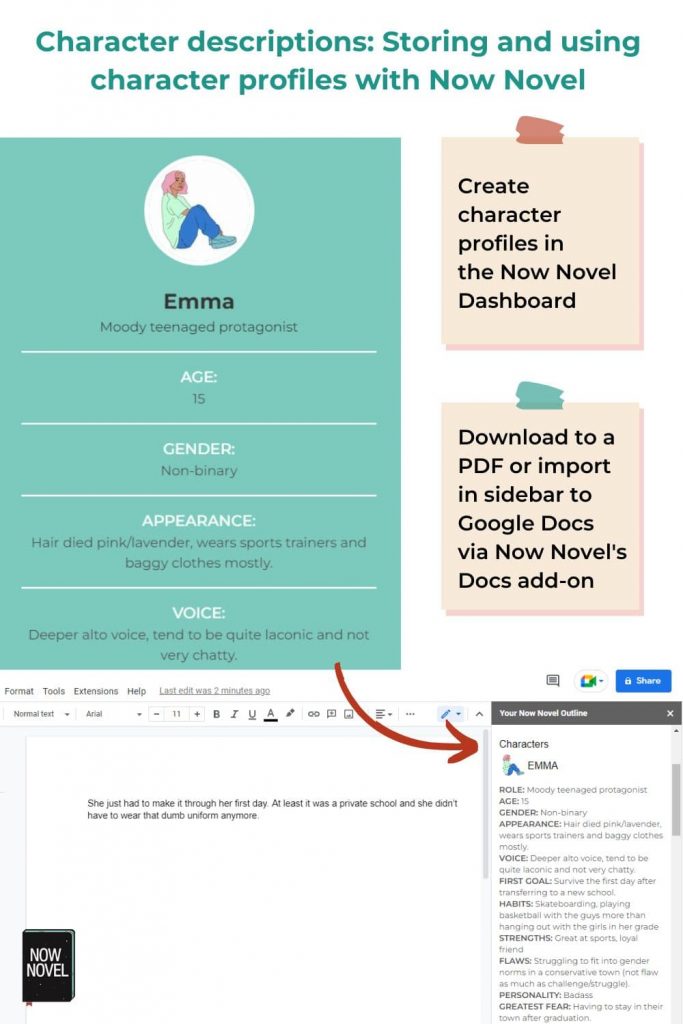
In our monthly writing craft webinars, writing coach Romy Sommer also suggests ‘reverse-casting’ your characters for inspiration:
2. Focus on details that reveal personality
A character’s hair or eye color doesn’t tell the reader much (there are other ways to use eye descriptions to build personality).
When you introduce a character, focus on details that reveal character personality or psychology .
Here’s Dostoevsky describing his character Katerina Ivanova (who has tuberculosis) in Crime and Punishment (1866):
Describe habitual actions to reveal personality
Katerina Ivanovna had just begun, as she always did at every free moment, walking to and fro in her little room from window to stove and back again, with her arms folded across her chest, talking to herself and coughing. Fyodor Dostoevsky, Crime and Punishment (1866), Chapter 7.
Dostoevsky conveys Katerina’s fragile mental health and state clearly. The coughing is a reminder of her life-threatening condition. The fact she continues to pace despite her discomfort suggests her determined, fighting spirit, which we see in further scenes.
You could also use descriptions of a character’s physical appearance to show their personalities, for example: ‘Jenna’s curly hair was bouncy, like her character. bouncy and bubbly.’
Use objects such as possessions left behind to suggest persona
The acclaimed short story author Alice Munro is a master of understated character development.
In her story ‘Free Radicals’, Munro describes a recently-widowed woman named Nita coming to terms with her husband’s death:
She thought carefully, every morning when she first took her seat, of the places where Rich was not. He was not in the smaller bathroom, where his shaving things still were, along with the prescription pills for various troublesome but not serious ailments which he’d refused to throw out. Alice Munro, ‘Free Radicals’, available via The New Yorker
Munro creates the emotional affect of a deceased spouse’s absence by describing objects in detail that remain once they’ve gone.
A precise detail – the prescription pills Rich refused to throw out – describes something about his hoarding character.
Detail the type of behavior characters might exhibit
Another way to describe a character’s personality is to give an example of something they might do.
Further on in the story, Munro describe pranking behavior that was typical of Rich to suggest a playful nature:
He was of course not out on the half-scraped deck, ready to peer jokingly in the window – through which she might, in earlier days, have pretended to be alarmed at the sight of a peeping tom. Munro, ‘Free Radicals’
The details Munro shares combine character behavior (Rich’s joking at the window) and setting detail (pills left behind that he refused to discard) to simultaneously create a sense of character and place . Her details describe the way people inhabit their spaces. This creates Rich as a vivid, lingering, ghostly presence in Nita’s memory.
Make a Strong Start to your Book
Join Kickstart your Novel and get professional feedback on your first three chapters and story synopsis, plus workbooks and videos.

3. Practice describing people in brief
One thing to avoid in choosing how to describe a character in a story is an info dump.
Info-dumping character description makes your reader go, ‘Oh, the author wants to squeeze in everything they possibly can about their character.’ It alerts your reader to the author’s hand, the wizard behind the curtain conjuring Oz. Such spurious description may lose your reader.
Instead, pick a specific detail to focus on for an introduction, and bring in other visual or descriptive character details as they become relevant to the story/action.
Examples of how to describe people succinctly
Here are a few examples of character descriptions that are precise and impactful:
Her hair had been long and wavy brown then, natural in curl and colour, as he liked it, and her face bashful and soft – a reflection less of the way she was than of the way he wanted to see her. Alice Munro, ‘Dimensions’, Too Much Happiness (2009), p. 2. Available online .
Note how Munro succinctly creates a sense not only of a character’s appearance but how it is affected by her being in a controlling relationship (which we find out more about as the story continues).
A sense of time and change is bundled with character description as we read a factor that shaped the protagonist Doree’s past appearance, now changed at the story’s start.
Below, Kent Haruf uses simile drawn from two elderly brothers’ farmland world to describe their appearance:
Their faces were red and weather-blasted below their white foreheads, the coarse hair on their round heads grown iron-gray and as stiff as the roached mane of a horse. Kent Haruf, Eventide (2004), p. 3.
Practice describing characters in three lines or less. What can you compare their appearance to? What does it say about them?
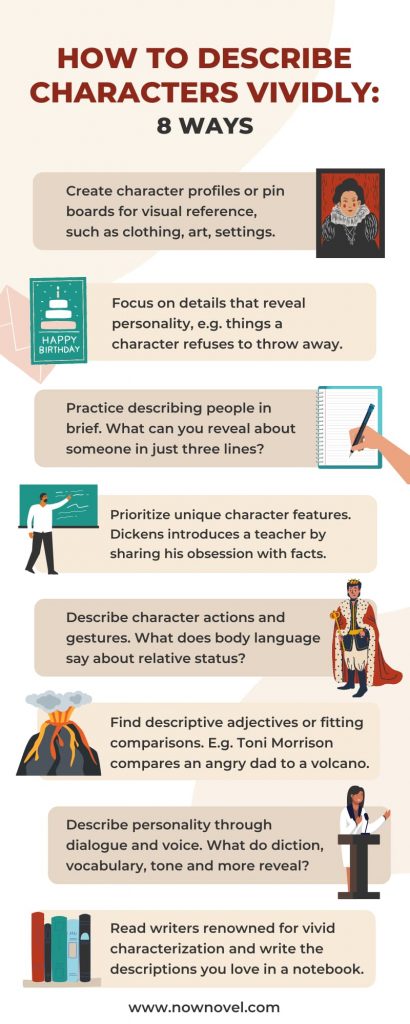
4. Prioritize unique character features
A large part of learning how to describe a person believably is showing what makes them unique or distinctive.
The Victorian author Charles Dickens, a master of characterization, described people with vivid, characteristic humor.
Here Dickens describes the schoolmaster Thomas Gradgrind, ‘a man of facts and calculations’ in his novel Hard Times (1854):
The emphasis was helped by the speaker’s voice, which was inflexible, dry, and dictatorial. The emphasis was helped by the speaker’s hair, which bristled on the skirts of his bald head, a plantation of firs to keep the wind from its shining surface, all covered with knobs, like the crust of a plum pie, as if the head had scarcely warehouse-room for the hard facts stored inside. Charles Dickens, Hard Times (1854), full text on Project Gutenberg .
Although Dickens describes his character’s hair, he uses a striking visual metaphor (‘a plantation of firs’).
This leads quickly back to description showing the schoolmaster’s fact-obsessed nature (‘…as if the head had scarcely warehouse-room for the hard facts stored inside’).
Dickens takes the description of Gradgrind as obstinate and fact-obsessed further:
The speaker’s obstinate carriage, square coat, square legs, square shoulders, – nay, his very neckcloth, trained to take him by the throat with an unaccommodating grasp, like a stubborn fact, as it was, – all helped the emphasis. Dickens, Hard Times
Thus Dickens mines a single, defining detail – Gradgrind’s tyrannical obsession with fact over imagination – for cohesive, comical description.
If Dickens had simply said ‘he was balding and inflexible and would lecture the students about facts’, this would create some sense of character. Dickens instead writes stronger description to show us what the character is like.
Yet the unique details Dickens chooses make Thomas Gradgrind especially vivid.

5. Describe character actions and gestures
Showing characters’ gestures and actions is an important part of bringing characters to life.
The way your characters move , their body language and gestures, is a key part of describing personality, status, or mental state.
In the example from Dostoevsky above, Katerina Ivanovna’s anxious pacing conveys her mounting fear over her husband (who drinks away the little money they have).
In Hard Times , Dickens uses movement and body language to reinforce the impression of Gradgrind as domineering and forceful:
“Girl number twenty,” said Mr. Gradgrind, squarely pointing with his square forefinger, “I don’t know that girl. Who is that girl?” “Sissy Jupe, sir,” explained number twenty, blushing, standing up, and curtseying. Dickens, Hard TImes
Dickens extends Gradgrind’s ‘squareness’ through his pointing. Sissy Jupe’s own body language conveys both her own bashfulness and the fact that Gradgrind wields stern authority over his pupils.
Dickens could simply use dialogue for the schoolmaster’s inquiry. Because of Gradgrind’s gestures, though, we get a clear sense of his dominant, demanding persona.

6. Find descriptive adjectives and fitting comparisons
There are two useful tools for accurate description of characters in stories: Precise, exact adjectives , and comparative language.
Finding adjectives to describe people with positive and negative connotations
Positive adjectives to describe a person include:
- Kindness: Kind, fair, caring, thoughtful, non-judgmental, respectful, loving
- Conscientiousness: Principled, upstanding, disciplined, rigorous, thorough, careful, decisive
- Selflessness: Selfless, giving, generous, dedicated
- Intelligence: Smart, insightful, perceptive, brainy, whip-smart, aware, informed, knowledgeable
- Attractive: Beautiful, stunning, gorgeous, hot, sexy, alluring, glamorous, studly, magnetic, hypnotic, fit [UK slang]
These are just some adjectives to describe a person in positive terms. If you need a good word for description:
- Look up a similar, broader word in a thesaurus.
- Find a word you like and look up its full definition and even etymology to ensure it has the right connotations (latent or associated meanings).
Negative adjectives to describe a person might include:
- Cruelty: Cruel, unkind, nasty, vicious, wicked, evil, despicable, malevolent, vindictive
- Ugliness: Hideous, vile, gross, creepy, fugly, monstrous, disgusting
- Boring: Dull, dreary, insufferable, tedious, insipid, bland
- Non-intelligence: Stupid, thick, ignorant, cretinous, basic
Keep in mind that some words to describe people negatively may have socially-offensive connotations (for example ‘dumb’ in the informal sense to mean stupid comes from ‘mute’).
If in doubt, find the most exact adjective whose connotations cannot be read another way.
Find fitting comparisons and use figurative language describing character
Comparisons are a great tool for writing character descriptions that are vivid. Look at how Dickens describes Gradgrind’s bald head in the example above, for example. Dickens uses metaphor (there is no ‘like’ or ‘as though’ which would make it a simile): ‘[Gradgrind’s hair] bristled on the skirts of his bald head, a plantation of firs to keep the wind from its shining surface.’
Now this isn’t the most fitting description (Gradgrind’s head has nothing to do with trees or a plantation of firs). Yet it conjures a precise, memorable image.
In Toni Morrison’s Song of Solomon , a father’s anger is shown using the metaphor of a volcano likely to erupt at an time.
Morrison extends this metaphor beautifully to show how Macon’s (the father) anger affects his daughters:
Solid, rumbling, likely to erupt without prior notice, Macon kept each member of his family awkward with fear. His hatred of his wife glittered and sparked in every word he spoke to her. The disappointment he felt in his daughters sifted down on them like ash, dulling their buttery complexions and choking the lilt out of what should have been girlish voices. Toni Morrison, Song of Solomon (1978), p. 10.
7. Describe personality via dialogue and voice
In deciding how to describe characters in your story, dialogue and voice in narration are two powerful tools to create a persona.
People’s speech describes so much about who they are:
- Tone : Is a person often angry, huffy, disappointed (like Macon in the example by Toni Morrison above)
- Vocabulary: Does the person have an extensive vocabulary suggesting they are educated or well-read or the opposite?
- Diction: Does the character have a marked accent, drawl, lisp or other distinguishing feature of the way they speak?
- Voice: What are the actual timbral qualities of your character’s voice? Is it high, low, or in-between? Loud or soft? Grating or pleasant to the hearer?
What your characters talk about (and what they leave unsaid) describes their persona in addition to visual descriptive details. Tweet This
8. Read writers renowned for their characterization
To learn how to describe a person brilliantly, collect memorable character descriptions . Read authors who are particularly noted for their vivid characters.
Many short story authors ( such as Anton Chekhov ) are good at compressing character detail into shorter passages.
Here, for example, is Chekhov describing his character Mihail Petrovitch Zotov, an old man, through dialogue and action tags in his story ‘The Dependents’:
“What an existence!” he grumbled, rolling crumbs of black bread round in his mouth. “It’s a dog’s life. No tea! And it isn’t as though I were a simple peasant: I’m an artisan and a house-owner. The disgrace!” Anton Chekhov, ‘The Dependents’, available online.
Chekhov combines this portrait of the character’s psychological state with description of his appearance:
Grumbling and talking to himself, Zotov put on his overcoat, which was like a crinoline, and, thrusting his feet into huge clumsy golosh-boots (made in the year 1867 by a bootmaker called Prohoritch), went out into the yard. Chekhov, ‘The Dependents’.
Start keeping a journal where you collect character descriptions that strike you as effective. This can become a useful source of inspiration to page through when you are sketching out your own characters.
Before concluding, let’s briefly take a look at how to detail character if you are writing in the first person. So far, we have looked at how to describe when you are writing in the third person point of view. First person description examples will need to be slightly different as you don’t have access to the omniscient narrator device.
There are various ways to do so, however, and effectively. For example another character could comment on the appearance of the first-person character. Here are some ways:
‘John looked at me with a shocked expression and asked why I had black dots under my eyes.’
‘I glanced into the mirror, and noticed my mascara had smudged, leaving a trail of black dots under each eye.’
Ready to flesh out your characters and get feedback on character descriptions? Start outlining characters , and get constructive feedback from the Now Novel community when you’re ready to revise.
Now Novel is a great platform for all writers to check out – especially for plotting, brainstorming, characterisation and even world building. Their customer service is top notch and I highly recommend NN!— MJ
Related Posts:
- How to describe hands: 6 ways to make characters real
- How to describe setting: 6 ways to bring setting to life
- How to start a novel in third person: 7 tips
- Tags character description , description writing , how to describe a person
Jordan is a writer, editor, community manager and product developer. He received his BA Honours in English Literature and his undergraduate in English Literature and Music from the University of Cape Town.
12 replies on “How to describe a person vividly: 8 ways”
Great post 🙂 Thanks for the tips!
Thanks, Amy! It’s a pleasure. Thanks for reading.
My name is Muhammad saqlain mushtaq I am from pakistan
Hi Muhammad, welcome to our blog. Let me know if you have any questions about character description (or anything else writing related) and I’ll do my best to answer them.
Thanks for very descriptive and inspiring inputs. Impressive and very helpful. This is helpful not only for me but also for everyone. My salute .
Hi Alex, it’s a pleasure. Thank you for reading our blog.
Hi😊 It’s your newest fan here. Thanks Jordan😊
Hi Glajol, I’m glad you’re a fan of our blog. Thank you for reading and saying hi.
I feel like everything you wrote was meant for me because I’m having alot of trouble describing my characters,so thanks alot
Hi Kaitlyn, I’m so glad to hear that. Hope your story goes well further.
Jordan- Wow! This information on building vivid characters is exactly what I was looking for. I am in the early stage of my writing career and struggling with describing my scene or setting and characters. Thank you for providing this resource. This information is great!
Dear Melika, Thanks so much for your comments! So pleased to hear them. All the very best with your writing.
Leave a Reply Cancel reply
Your email address will not be published. Required fields are marked *
Pin It on Pinterest
Descriptive Essay Writing
Descriptive Essay Examples

Amazing Descriptive Essay Examples for Your Help
Published on: Jun 21, 2023
Last updated on: Mar 1, 2024
-8521.jpg)
People also read
Interesting Descriptive Essay Topics - 2024
Writing a Descriptive Essay Outline - Tips & Examples
Descriptive Essay: Definition, Tips & Examples
Share this article
Descriptive essays are very commonly assigned essays. This type of essay enhances students' writing skills and allows them to think critically.
A descriptive essay is often referred to as the parent essay type. Other essays like argumentative essays, narrative essays, and expository essays fall into descriptive essays. Also, this essay helps the student enhance their ability to imagine the whole scene in mind by appealing senses.
It is assigned to high school students and all other students at different academic levels. Students make use of the human senses like touch, smell, etc., to make the descriptive essay more engaging for the readers.
On This Page On This Page -->
Examples make it easy for readers to understand things in a better way. Also, in a descriptive essay, different types of descriptions can be discussed.
Here are some amazing examples of a descriptive essay to make the concept easier for you.
Descriptive Essay Example 5 Paragraph
5 paragraphs essay writing format is the most common method of composing an essay. This format has 5 paragraphs in total. The sequence of the paragraphs is as follows;
- Introduction
- Body Paragraph 1
- Body Paragraph 2
- Body Paragraph 3
- Conclusion
Following is an example of a descriptive essay written using the famous 5 paragraph method.
5 Paragraph Descriptive Essay

Get More Examples From Our AI Essay Writer
Descriptive Essay Example About A Person
Descriptive essays are the best option when it comes to describing and writing about a person. A descriptive essay is written using the five human senses. It helps in creating a vivid image in the readerâs mind and understanding what the writer is trying to convey.
Here is one of the best descriptive essay examples about a person. Read it thoroughly and try to understand how a good descriptive essay is written on someoneâs personality.
Descriptive Essay Example About a Person
Descriptive Essay Example About A Place
If you have visited a good holiday spot or any other place and want to let your friends know about it. A descriptive essay can help you explain every detail and moment you had at that place.
Here is one of the good descriptive essay examples about a place. Use it as a sample and learn how you can write such an essay.

Tough Essay Due? Hire Tough Writers!
Descriptive Essay Example for Grade 6
Descriptive essays are frequently assigned to school students. This type of essay helps the students enhance their writing skills and helps them see things in a more analytical way.
If you are a 6 grader and looking for a good descriptive essay example, you are in the right place.
Descriptive Essay Example for Grade 7
Here is one of the best descriptive essay examples for grade 7.
Descriptive Essay Example for Grade 8
If you are looking for some amazing descriptive essay examples for grade 8, you have already found one. Look at the given example and see what a well-written descriptive essay looks like.
Descriptive Essay Example for Grade 10
Essay writing is an inevitable part of a student's academic life . No matter your grade, you will get to write some sort of essay at least once.
Here is an example of a descriptive essay writing for grade10. If you are also a student of this grade, this example might help you to complete your assignment.
Descriptive Essay Example for Grade 12
If you are a senior student and looking for some essay examples, you are exactly where you should be.
Use the below-mentioned example and learn how to write a good essay according to the instructions given to you.
Descriptive Essay Example College
Descriptive essays are a great way to teach students how they can become better writers. Writing a descriptive essay encourages them to see the world more analytically.
Below is an example that will help you and make your writing process easy.
College Descriptive Essay Example
Descriptive Essay Example for University
Descriptive essays are assigned to students at all academic levels. University students are also assigned descriptive essay writing assignments. As they are students of higher educational levels, they are often given a bit of difficult and more descriptive topics.
See the example below and know what a descriptive essay at the university level looks like.
Short Descriptive Essay Example
Every time a descriptive essay isn't written in detail. It depends on the topic of how long the essay will be.
For instance, look at one of the short descriptive essay examples given below. See how the writer has conveyed the concept in a composed way.
Objective Descriptive Essay Example
When writing an objective description essay, you focus on describing the object without conveying your emotions, feelings, or personal reactions. The writer uses sight, sound, or touch for readers' minds to bring life into pictures that were painted by words.
Here is an example that you can use for your help.
Narrative and Descriptive Essay Example
A narrative descriptive essay can be a great way to share your experiences with others. It is a story that teaches a lesson you have learned. The following is an example of a perfect narrative descriptive essay to help you get started.
Paper Due? Why Suffer? That's our Job!
How to Start a Descriptive Essay? - Example
If you don't know how to start your descriptive essay, check this example and create a perfect one.
How to Start a Descriptive Essay - Example
Subjective Descriptive Essay Example
It is a common concept that a descriptive essay revolves around one subject. Be it a place, person, event, or any other object you can think of.
Following is one of the subjective descriptive, easy examples. Use it as a guide to writing an effective descriptive essay yourself.
Writing a descriptive essay is a time-consuming yet tricky task. It needs some very strong writing, analytical, and critical thinking skills. Also, this is a type of essay that a student can not avoid and bypass.
But if you think wisely, work smart, and stay calm, you can get over it easily. Learn how to write a descriptive essay from a short guide given below.
How to Write a Descriptive Essay?
A writer writes a descriptive essay from their knowledge and imaginative mind. In this essay, the writer describes what he has seen or experienced, or ever heard from someone. For a descriptive essay, it is important to stay focused on one point. Also, the writer should use figurative language so that the reader can imagine the situation in mind.
The following are some very basic yet important steps that can help you write an amazing descriptive essay easily.
- Choose a Topic
For a descriptive essay, you must choose a vast topic to allow you to express yourself freely. Also, make sure that the topic you choose is not overdone. An overdone will not grab the attention of your intended audience. Check out our descriptive essay topics blog for a variety of intriguing topic suggestions.
- Create a Strong Thesis Statement
A thesis statement is the essence of any academic writing. When you select the descriptive essay topic, then you create a strong thesis statement for your essay.
A thesis statement is a sentence or two that explains the whole idea of your essay to the reader. It is stated in the introductory paragraph of the essay. The word choice for creating the thesis statement must be very expressive, composed, and meaningful. Also, use vivid language for the thesis statement.
- Collect the Necessary Information
Once you have created the thesis statement and are done writing your essay introduction . Now, it's time to move toward the body paragraphs.
Collect all necessary information related to your topic. You would be adding this information to your essay to support your thesis statement. Make sure that you collect information from authentic sources.
To enhance your essay, make use of some adjectives and adverbs. To make your descriptive essay more vivid, try to incorporate sensory details like touch, taste, sight, and smell.
- Create a Descriptive Essay Outline
An outline is yet another necessary element of your college essay. By reading the descriptive essay outline , the reader feels a sense of logic and a guide for the essay.
In the outline, you need to write an introduction, thesis statement, body paragraphs and end up with a formal conclusion.
Proofreading is a simple procedure in which the writer revises the written essay. This is done in order to rectify the document for any kind of spelling or grammatical mistakes. Thus, proofreading makes high-quality content and gives a professional touch to it.
You might be uncertain about writing a good enough descriptive essay and impress your teacher. However, it is very common, so you do not need to stress out.
Hit us up at CollegeEssay.org and get an essay written by our professional descriptive essay writers. Our essay writing service for students aims to help clients in every way possible and ease their stress. Get in touch with our customer support team, and they will take care of all your queries related to your writing.
You can always enhance your writing skills by leveraging the power of our AI essay writing tools .
Place your order now and let all your stress go away in a blink!
Barbara P (Literature)
Barbara is a highly educated and qualified author with a Ph.D. in public health from an Ivy League university. She has spent a significant amount of time working in the medical field, conducting a thorough study on a variety of health issues. Her work has been published in several major publications.
Paper Due? Why Suffer? That’s our Job!

Keep reading

- Privacy Policy
- Cookies Policy
- Terms of Use
- Refunds & Cancellations
- Our Writers
- Success Stories
- Our Guarantees
- Affiliate Program
- Referral Program
- AI Essay Writer
Disclaimer: All client orders are completed by our team of highly qualified human writers. The essays and papers provided by us are not to be used for submission but rather as learning models only.
- Dissertation
- PowerPoint Presentation
- Book Report/Review
- Research Proposal
- Math Problems
- Proofreading
- Movie Review
- Cover Letter Writing
- Personal Statement
- Nursing Paper
- Argumentative Essay
- Research Paper
Descriptive Essay About a Person

Table of Contents

The last type is probably the most difficult because the description of a person won’t include the appearance only, but would also consider character, temperament, behavior, and so on.
If you really want to write a high-quality descriptive essay, you should be attentive, competent, and … creative.
We understand that this essay type can be a real challenge; that’s why we would try to provide you with the most valuable recommendations on how to write a descriptive essay about a person.
What is the specifics of the descriptive essay about a person?
First, you should choose the person who will be the subject of this description. For example, you can write a descriptive essay about a person you love. On the other hand, we are not sure that the number of people who are interested in this article will not be awe-inspiring and your paper may be a bit boring for other people.
So, writers usually decide to create essays about an extraordinary historical personality or write a descriptive essay about a person you admire. For example, you can write an essay about Napoleon Bonaparte, Martin Luther King, Ronald Reagan, or other famous and successful people to consider their personalities more precisely.
Describe the features of the person one by one, like:
- Appearance. How to start a descriptive essay about a person? Clothes make the man! So, it should be the first part of your writing. Describe facial features, height, weight, hair color, eye color, clothes, and so on.
- Manners. After that, you can describe the most typical acts and behaves of this man or woman. If you decided to consider famous people, it could help to detect the name of your subject from the very beginning. For example, if you say that this man liked to smoke cigars, drink alcohol, and wear hats, it will not be a problem to assume that it is Winston Churchill.
- Character traits. This part is probably the most difficult because you can describe the appearance of this person without any additional help. Just analyze photos and write your text. However, if you need to consider the most significant character traits, it’s recommended to read memoirs or look for articles of experienced historians.
- Emotions. You can watch videos or analyze special materials to figure out the emotional state of your subject. Don’t forget to mention whether this human is choleric, phlegmatic, melancholic, or sanguine. Don’t forget to mention its sense of humor as well.
Use free descriptive essay example about a person to avoid mistakes
Don’t forget that you are not the first author on the Internet who has to write this article. Fortunately, there are dozens of websites, which provide descriptive essay examples about a person.
We don’t recommend you to use any descriptive essay about a person you admire example as your own article because you will fail all anti-plagiarism tests. However, this sample could be a great pattern, which you can use in the future.
How to write a descriptive essay about a person: simple tips
Of course, these recommendations don’t guarantee your future success in this sphere, but we strongly recommend you to use them to minimize risks and increase the quality of your paper:
For example, you can find info about the number of bottles of wine which this man consumes every day or the number of brothers and sisters of this particular subject.
“He is very tall and has big blue eyes.”
- Choose people, you know well. Remember! You should choose people whom you know good enough to write an article about them. On the other hand, if you decided to consider the main features of a star, you should research more information about this person before choosing the topic.
- Find the balance. We are sure that it’s not enough to use even several paragraphs if you really want to describe each feature of this person, but a lot of info can overload your text. So, you should find the ideal balance between informative and concise. We can recommend you to write down 3-4 the most recognizable features of this person and stay focused on them. Describe them well, and it would be significantly better than writing about nose, mouth, eyebrows, lips, arms, legs, and other parts of the body of this person.
… Final thoughts
Therefore, it’s not an easy task. In most cases, it takes at least 5-6 hours to write a high-quality paper.
Luckily, you may manage to avoid a lot of problems and make this process more comfortable if you try to analyze any sample descriptive essay about a person and follow our simple recommendations.
Ain’t in the mood for writing a descriptive essay about a person? Guess who is! Yeah, our writers are the best. And always available, by the way…

How Can I Make An A+ Editing Checklist For My Essay?

How to Write an Argumentative Essay: Your Ultimate Guide
100 proposal topics ideas for your assignment.

Descriptive Essay

Essays are written due to various reasons and purposes. Some of the authors want to inform, some want to expose while some want to persuade. However, in descriptive essay writing , the essayist composes for the sake of displaying a picture out of his/her describing words. It may sound easy and simple but don’t be deceived, there are still more to learn. Read through this article to get hold of significant and beneficial new knowledge.
What is Descriptive Essay? A descriptive essay is a type of writing that aims to vividly describe a person, place, object, or event. In this type of essay, the writer uses sensory details such as sight, sound, smell, taste, and touch to create a clear and vivid image in the reader’s mind. The goal of a descriptive essay is to evoke a strong emotional response or create a vivid impression of the subject being described.
Descriptive Essay Format
Introduction.
Hook: Start with a sentence that captures the reader’s attention. This could be a striking fact, a question, or a vivid description. Context: Provide some background information to set the scene. Describe the setting, the situation, or the object of the essay. Thesis Statement: End the introduction with a clear thesis statement that outlines the main aspects or the overall impression of your subject.
Body Paragraphs
Each body paragraph should focus on a specific aspect or a detail that contributes to the overall picture you are trying to paint. Use the “show, don’t tell” technique by employing vivid imagery and sensory details.
Paragraph 1: Sight
Topic Sentence: Introduce the aspect of sight. Details: Describe what you see in vivid detail. Use adjectives and adverbs to bring the scene to life. Closing Sentence: Wrap up the paragraph by summarizing the importance of the visual details.
Paragraph 2: Sound
Topic Sentence: Focus on the sounds related to your topic. Details: Describe what can be heard, whether it’s the background noise, a specific sound related to the subject, or the absence of sound. Closing Sentence: Conclude by explaining how the sounds contribute to the overall impression.
Paragraph 3: Smell
Topic Sentence: Highlight the aspect of smell. Details: Describe the aromas and scents. Whether it’s pleasant or pungent, detail how it impacts the scene or the subject. Closing Sentence: Summarize how the smell adds to the depth of your description.
Paragraph 4: Touch
Topic Sentence: Discuss the sense of touch. Details: Describe the textures and temperatures. Explain how something feels to the touch and why it’s important to your description. Closing Sentence: Link the tactile details to the overall experience.
Paragraph 5: Taste (if applicable)
Topic Sentence: Introduce the sense of taste, if relevant. Details: Describe the flavors and the experience of tasting something related to your subject. Closing Sentence: Reflect on how taste enhances the description.
Summary: Briefly restate your thesis and summarize the main points of your essay. Significance: Explain the significance of the subject and the impact it has made on you or the impression it leaves. Closing Thought: End with a final thought or reflection, leaving the reader with something to ponder.
Example of Descriptive Essay
“The Sunset at the Beach” As I walked down the sandy path towards the ocean, the first thing that struck me was the vast expanse of the sea, stretching endlessly towards the horizon. The sun was beginning to set, painting the sky in shades of orange, pink, and purple. The beauty of the sunset at the beach was a breathtaking spectacle that I had come to witness. Introduction The beach has always been a place of serenity for me, especially during the sunset. The way the sun dipped below the horizon, leaving behind a tapestry of colors, always seemed magical. On this particular evening, the scene was set for a perfect display of nature’s artistry. Body Paragraphs The Vision of the Sunset As I stepped onto the soft, warm sand, my eyes were immediately drawn to the horizon. The sun, a fiery orb, was slowly descending, casting its golden glow across the sky. The clouds, mere wisps earlier in the day, now looked like cotton candy, stained with hues of pink and lavender. The reflection of the sunset on the water added a layer of brilliance to the scene, with the light dancing on the waves as they gently lapped against the shore. The Symphony of the Waves The sound of the waves provided a soothing background melody to the visual spectacle. Each wave crashed against the shore with a rhythm that was both calming and invigorating. In the distance, seagulls called to one another, their cries adding to the orchestral performance of nature. The rustling of the palm leaves in the gentle breeze played a soft, whispering harmony, creating a symphony that only the beach at sunset could offer. The Aromatic Breeze With every breath, the salty tang of the sea air filled my lungs, a distinctive aroma that immediately relaxed my body and mind. There was a freshness to it, a reminder of the vast, untamed ocean before me. Mixed with the faint scent of sunscreen and the earthiness of wet sand, the beach’s aroma was invigorating, grounding me in the moment. The Touch of Nature As I walked along the water’s edge, the cool water washed over my feet, providing relief from the day’s residual heat. The sand, now cooler than the afternoon sun, felt soft and comforting beneath my toes. Occasionally, a stronger wave would rush further up the beach, encouraging me to dig my feet into the sand, feeling the grains shift against my skin. Conclusion The sunset at the beach was not just a visual masterpiece; it was an experience that engaged all the senses. As the sun finally disappeared, leaving behind a sky painted in dark blues and purples, I felt a sense of peace and contentment. The beach at sunset had offered me a moment of beauty, tranquility, and a deep connection with nature. It was an unforgettable scene, etched in my memory, reminding me of the simple, yet profound joys of life.
Descriptive essays generally focus more on visualizing a specific topic of interest. Considering that aspect, showing you what it looks like may be helpful as well. Thus, we cautiously gathered the best samples and templates of descriptive essays for you to rely on, here are they:
Bright Topic Ideas for Your Descriptive Essay
The list of the possible topic ideas for your descriptive essay is limitless. There are a lot of choices to choose from and sometimes, it is really difficult to pick one. If you are being indecisive regarding your topic idea, here are some smart concepts to help you select one.
Descriptive Essay Ideas About People
- Description of your favorite music genre
- Treating a popular villain as a good protagonist
- The right words that would compliment your singing idol
- Why your squad is the best?
- What qualities should your future spouse possess?
- Why your aunt is the best?
Descriptive Essay Ideas About Places
- Why Manila Bay has the best sunset?
- The perfect adjective to describe your hometown
- Details on your recent vacation destination
- Why your favorite coffee shop is worth the visit?
- What makes Paris unique?
- The best description for your workplace
Descriptive Essay Ideas About Things
- Why your wedding ring is the most luxurious?
- The description of your favorite blanket
- What makes your research paper great?
- Description of your proposed food product
- Perfume: more than just the bottle
- Why your bag is great
Descriptive Essay Examples & Templates
Descriptive narrative essay example.

Descriptive Essay Outline Example

Short Essay Plan Example
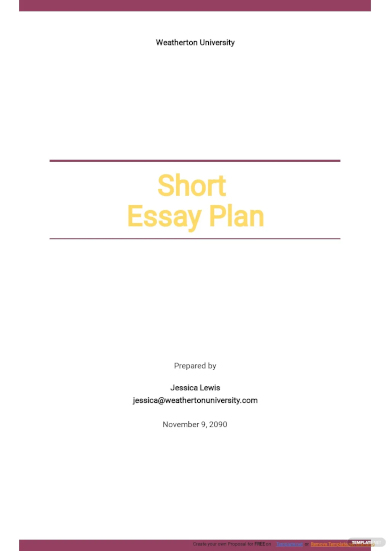
Biographical Narrative Essay Example

College Narrative Essay Example
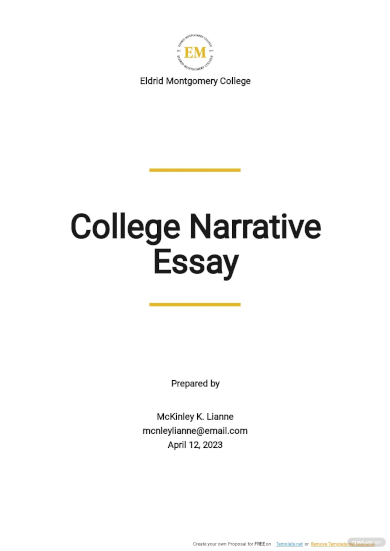
Personal Narrative Essay Example

Short Narrative Essay Example
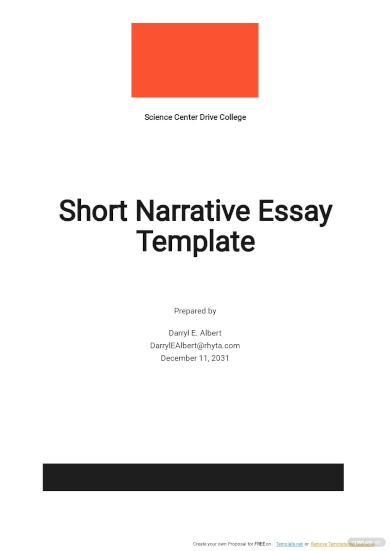
High School Descriptive Essay Example

Free Simple Descriptive Essay Plan
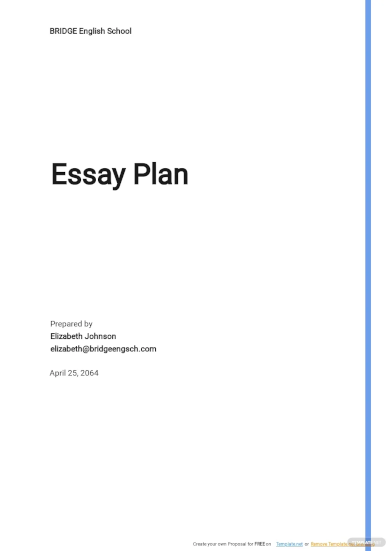
Basic Descriptive Essay Writing Example

latterdaylearning.org
Short Descriptive Essay Example

trudyamiller.wikispaces.com
Descriptive Essay Structuring Example
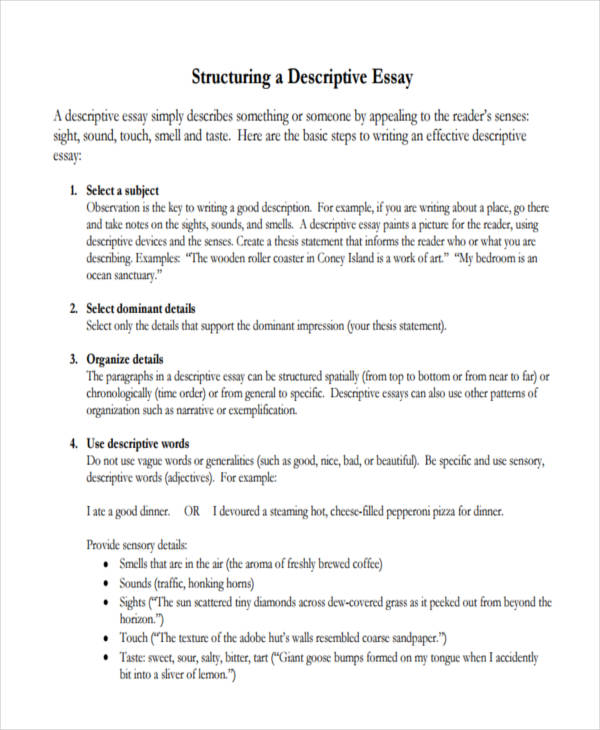
colegiobennett.org
Simple Descriptive Essay Example
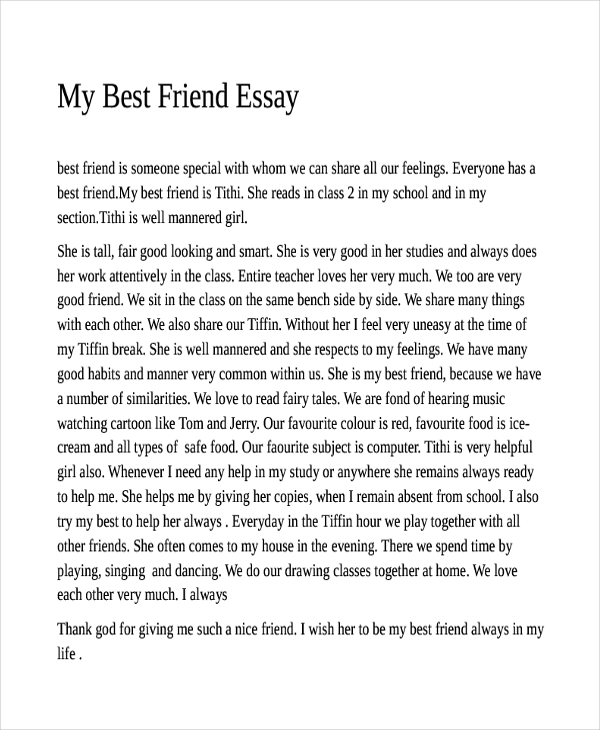
essssay.com
Narrative Descriptive Essay Example

preservearticles.com
Descriptive Essay Prewriting Example

fileserver.net-texts.com
Personal Descriptive Essay Example
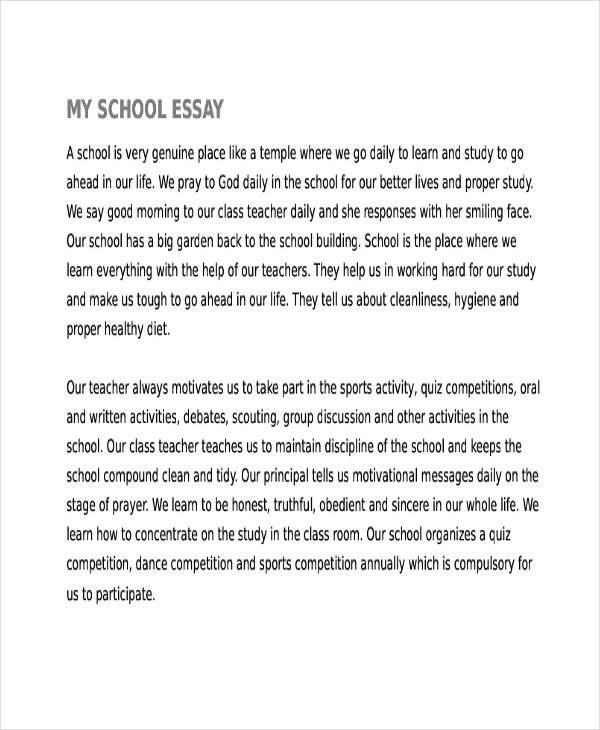
indiacelebrating.com
Descriptive Essay Characteristics Example

Descriptive Essay Description Guide Example
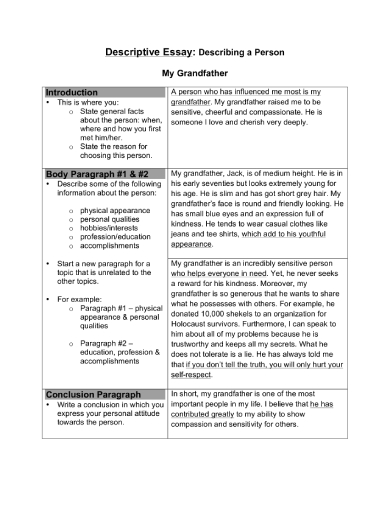
ortbinyaminaenglish.yolasite.com
Descriptive Essays about Places Example
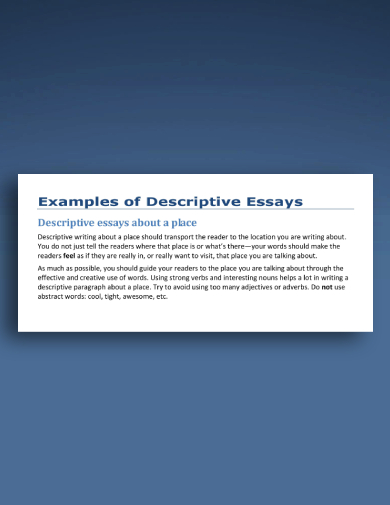
Excellent Descriptive Essay Example
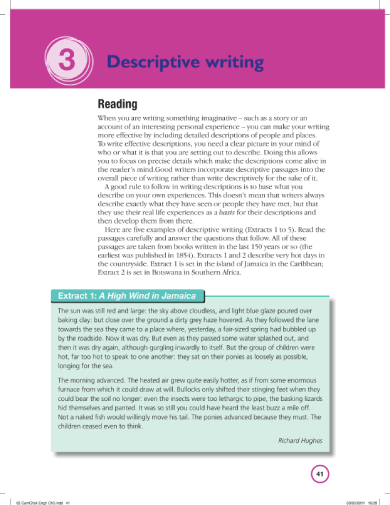
hoddereducation.co.uk
Descriptive Essay Writing Exercise Example

Educational Descriptive Essay Example

owll.massey.ac.nz
Spring Break Descriptive Essay Example
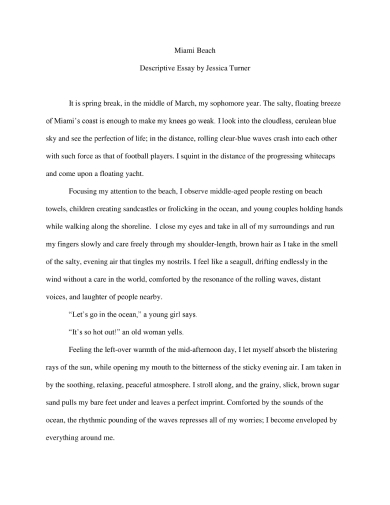
cheylin.com
Descriptive Essay Sentence Writing Example
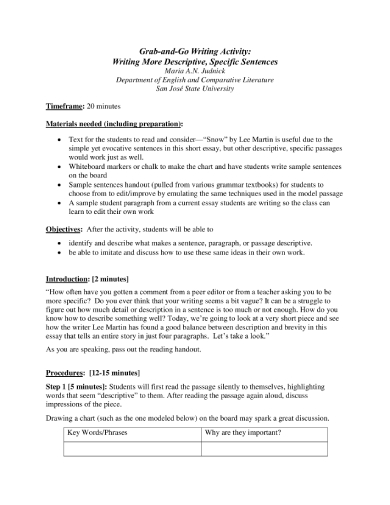
Descriptive Essay Paragraph Guidelines Example
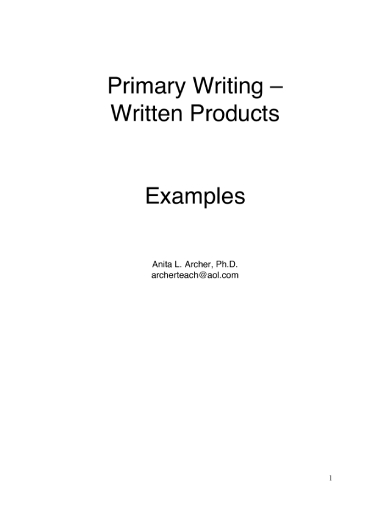
Stylish Descriptive Essay Rubric Example
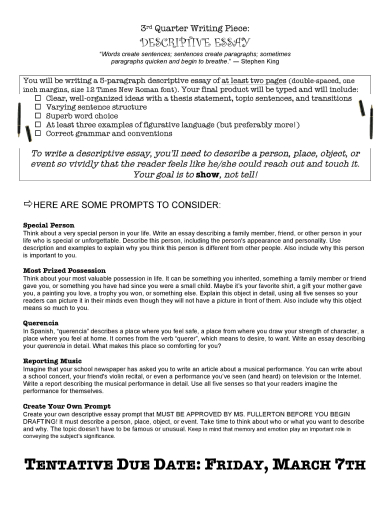
Descriptive Essay Writing Techniques Example
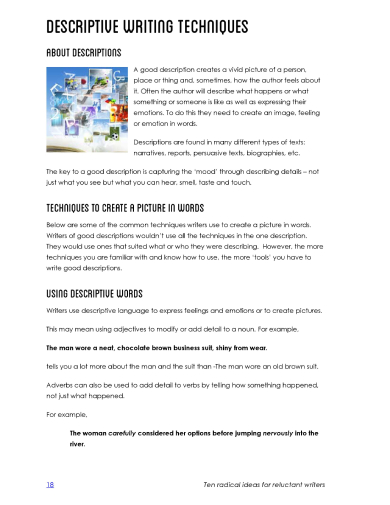
multifangled.com.au
Free Descriptive Essay Example
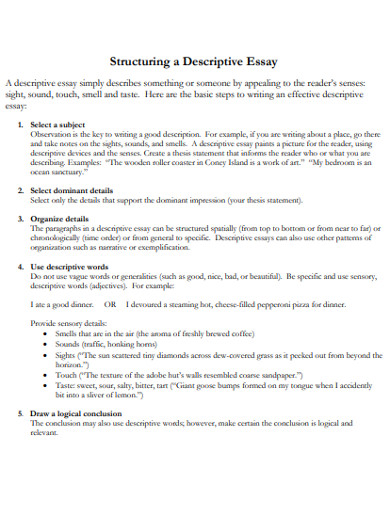
asc.weebly.com
Basic Descriptive Essay Example

hortonskids.org
Sample Descriptive Essay Example

essaytigers.com
Descriptive Essay in PDF Example
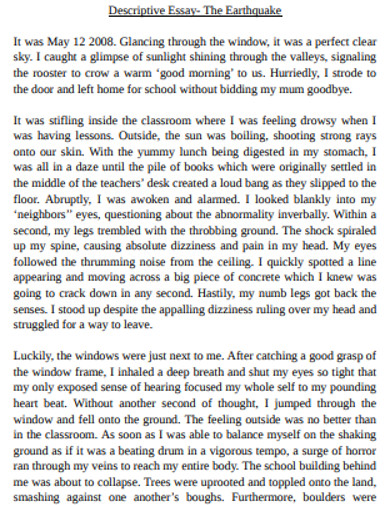
Printable Descriptive Essay Example
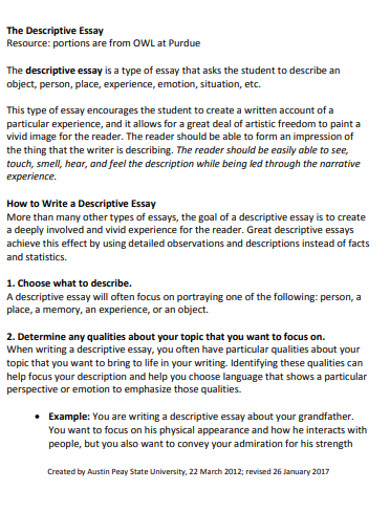
Direction Descriptive Essay Example
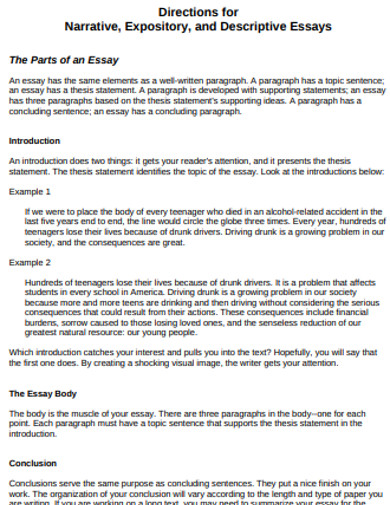
wba.aplusanywhere.com
Descriptive Essay Scoring Guide
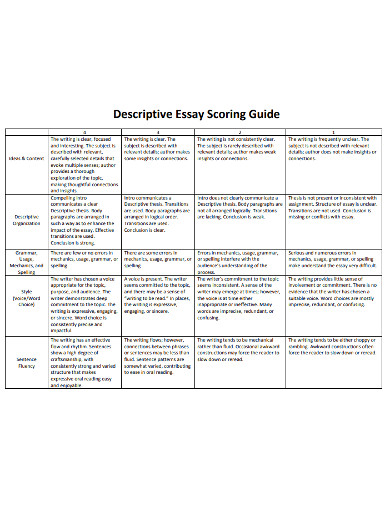
washoeschools.net
Professional Descriptive Essay

Descriptive Essay Format Example
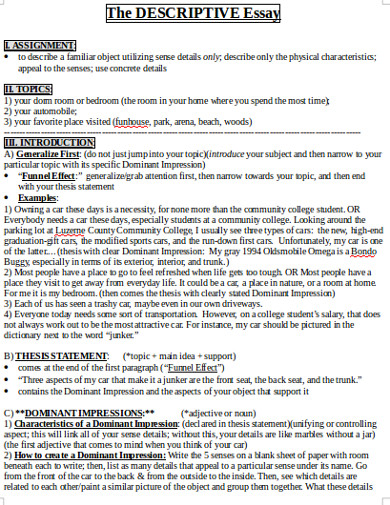
staff.kings.edu
Assignment Descriptive Essay Example

fd.valenciacollege.edu
What are the 4 types of essays?
An essay is an extended piece or composition that shows and supports a thesis or proposition. Essays help the expression of an author’s ideas in various ways. Before composing your own essay, it is important to identify its purpose first, and in doing that, distinguishing its type would be a great beginning. Correspondingly, here are the four different types of essays:
Narrative Essays: to tell
Taking it into its most basic sense, narrative essays are used if the author wants to tell a story about a real-life adventure. This type of essay is expressed in a particular point-of-view. Commonly, it is the author’s viewpoint that is being followed. Moreover, in writing your own short narrative essay , apply realistic emotions and appropriate sensory details to provide your readers with the full taste of your story. By doing this, you are not simply telling them but also engaging them in the story’s sequence and elements. It is also advisable to state verbs as vivid and as precise as possible. The thesis statement of a narrative essay is commonly found in the opening sentence or the last sentence of the introductory paragraph.
Descriptive Essays: to describe
You may confuse yourself between narrative and descriptive essays ; however, differentiating both is really easy. Rather than telling a story, a descriptive essay illustrates a specific topic such as a person, place, experience, emotion, event, etc. by means of words. You don’t simply state your experience in this type of essay; on top of that, you let your reader experience the same thing through your descriptions. In writing your own short descriptive essay , it is important to remember that you are not writing to tell but to show. Using sensory and vivid words is also recommended.
Expository Essays: to uncover and clarify
From its name itself, an expository essay is used to expose something on matters that are known to others. This type of essay is a genre of composition that aims to explain, illustrate, clarify or explicate a certain subject for the readers. Thus, an expository essay could include investigation and evaluation of ideas. This could be derived through comparison and contrast, definition, giving examples, assessment of cause and effect, etc. Moreover, in composing an expository essay, the author set his/her emotions aside for this type of essay is based on mere facts. The first point-of-view is not applied in this essay as well.
Persuasive Essays: to convince
If the expository essays talk about the facts then persuasive essays talk about arguments. The main purpose of a persuasive essay is to win over the trust of the reader to accept your viewpoint, opinion or proposition as the author. In writing a persuasive essay, your opinions should be supported by relevant facts and logical and sound reasoning. Though the essayist should lay all necessary details from both sides of the argument, he/she must comprehensibly explain why one side is correct or more favorable than the other.
Despite essays being categorized into four types, it is also important to know that an essay is not limited to one type only. In some cases, a narrative essay could also be mixed with a short descriptive essay or a short persuasive essay combined with an expository type. Nevertheless, identifying the purpose of your essay is vital before writing. However, if doing it challenges you, knowing these types is a great substitute.
What Is the Purpose of a Descriptive Essay?
Some people like to watch movies rather than to read books. This is because an actual image is easier to absorb than that on writing. This is why it’s important for a writer to pay close attention to detail. A descriptive essay conclusion should provide the reader with a mental picture of a given matter.
This is especially essential when writing pieces meant for a younger audience, as they have a more imaginative mind than the average adult. A writer must be creative when using imaginative language in order for the reader to properly comprehend what is being portrayed. To do so, the writer should also be knowledgeable about the topic. After all, you don’t want to give your readers the wrong interpretation .
How to Write a Descriptive Essay
A good descriptive essay comes from a knowledgeable and imaginative mind. Thus, in descriptive writing , it’s important for one to be specific on details. After seeing a few samples that we have shown earlier, here is a step-by-step guideline to help you in composing a descriptive essay worth reading.
1. Choose a topic.
If there is no given topic, it would be great to select one that you are knowledgeable and familiar with. Considering that your whole descriptive essay would revolve on this specific subject, choosing a topic that you recognize would keep everything simpler for you. By doing such, you can freely decide what words are the most appropriate to use; as a result, it will be easier for you to describe your topic. Furthermore, your reader could be meticulous and educated on your subject, so being knowledgeable about your own topic is wise prevention against bad impression.
2. Construct your thesis statement.
Alright, now that you have your own topic already, it is important to know what specific message you want your reader should focus on reading your whole essay. Thus, it is important to always provide a thesis statement , the umbrella sentence of all your ideas. Write this in one concise sentence in your introduction and conclusion. Often, a thesis statement is mentioned in the last sentence of your introductory paragraph.
3. Gather the necessary information and ideas.
Though you are already proficient in your topic, it is still recommendable to research about your specific subject. With this, you are not just gaining new information but also checking the correctness of your knowledge. It would also be great to expand your vocabulary, especially in adjectives and adverbs, since writing one of these involve loads of describing. Moreover, also focus on the sensory words that correspond to sight, smell, taste, sound, and touch of the given subject.
4. Create an outline.
Obtaining all of the significant details, crafting an essay outline for your work will allow you to arrange your contents in a rational and chronological order. Also, being educated with different formats in writing an essay would really make a great difference in your composition.
5. Proofread.
After writing your own descriptive essay, it might feel perfect already, but most of the time, it is not. Hence, read your entire work and review if there are any errors pertaining to your grammar and spelling. Furthermore, asking for help from a well-versed friend of yours to conduct a peer-review to your work would be extremely useful.
6. Finalize your composition.
The next thing to do after the editing is to finalize your descriptive essay to its finest version. Make sure that your essay follows a specific format, consisting of the proper parts of the essay .
Smart Tips for Writing a Descriptive Essay
The fundamentals of the descriptive writing procedures are now given to you; nevertheless, it would always be great to aim for something better. Now, here are some intelligent tips that would make your essay certainly more compelling.
Establish a connection with your writing.
The key to writing a good effective essay is to have the passion to write it; thus, in choosing your topic it would be great to have a familiar one or a subject that truly makes you curious. Let your interest be the seed of your fruitful composition.
Spend time to think.
In writing your own descriptive essay, let your brain do its job. Do not rush, give yourself an adequate amount of time to ponder on the necessary details that you should include and what approach you should apply. Provide yourself a clear plan of your descriptive essay writing. Moreover, look at your topic from different angles. This will allow you to take a closer look at every detail of your subject.
Apply the word vomit technique.
The word vomit technique or also called as “ free writing ” is the spontaneous use of words without considering any rules. This is a good technique in making a draft of your starting an essay . It allows your ideas to keep flowing without exerting much effort. Once this is done, you can pick out points that would go well with your essay.
Take a break before finalizing it.
Because right after writing your composition, your thought highly recognizes your word construction; thus, it does not really notice the errors and automatically treats them as correct pieces of your work. Allowing your mind to clear out for a while will make it easier for you to critic your own work. Furthermore, utilizing grammar-checking software is also a splendid move.

Descriptive Essay Generator
Text prompt
- Instructive
- Professional
Write a descriptive essay about a place you love to visit and what makes it special.
Describe in a descriptive essay your dream job and what it would be like to work there.
404 Not found
- How It Works
- Essay Examples
Writing Descriptive Essays about People
Descriptive essays are essays that usually describe something which includes places, emotions, situations, or even people. Descriptive essays about people can prove more difficult as many times we do not see these types of descriptions in books or popular literature. If there is a description of a person, it is usually short, within one paragraph, or spans across the entire book. Because of this, a descriptive essay about people can be challenging for those just learning. We have provided some tips and other strategies when writing descriptive essays. Psychology essay example page will help as well. The three biggest tips for writing descriptive essays are to use a person you know, bear in mind that actions speak louder than words, and make the most of the personality traits.
1. Use a Person You Know
Using a person you know can build a foundation for descriptions. This can be family members, friends, actors, or your favorite artist. Knowing what they look like can help with the process as you can pull up the mental image of them in your head for reference at any point. For a lower level entry essay, this can be your entire topic. If you want to describe a made-up person, you could use a collaboration of people you know in your life. You can also base it off on someone you know and change some key features making them unique to your story. The goal is to make the description of the person as authentic as possible, so using someone who is real can get the ball rolling. If you don't know the person as well as you want, try and schedule an interview. This should let you learn more about them in both physical and mental aspects. Basing a character on a real person can help them become more realistic. For example, you are going to describe a girl that is breathtakingly beautiful, you might base her on Marilyn Monroe. In the description, you could say:
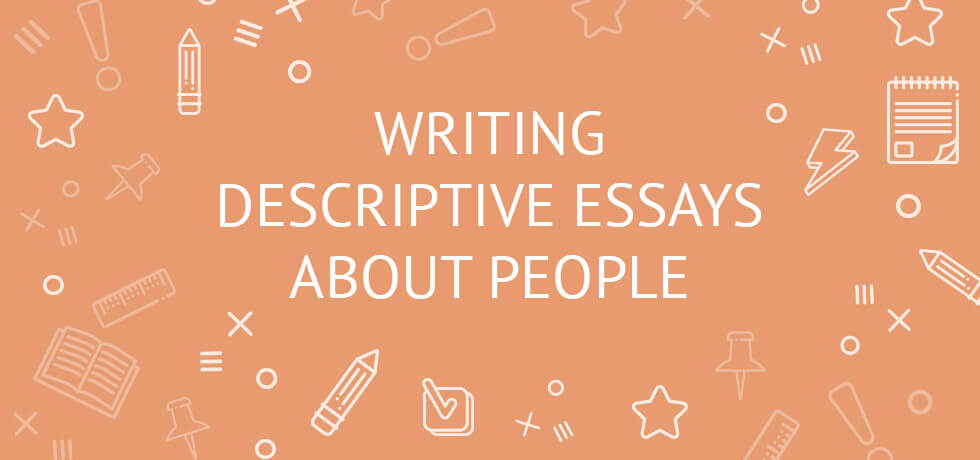
She has golden curly hair that framed her perfectly symmetrical face. Lips that were bright red making her teeth light up with a smile. Her eyebrows were long and slim. She had a slim body and well-tanned skin which makes fitting into a dress and going out look easy. She had a distinctive mole on the left side of her face right outside her dimples. Although some found it off-putting, I found it completed her.
2. Actions Speak Louder than Words
A descriptive essay that describes the character in one paragraph can be detrimental. In fact, many physical descriptions in popular literary work are not short, and as characters, physical personalities are shown throughout the book. Take a look back to your favorite book and think how the characters were revealed to you. Many of them use the span of the book or series of books to show character traits, flaws, and even sometimes descriptions. How do they do this? Many authors use actions or behaviors to speak for the character. Reveal only bits and pieces of the character as you write the story. As the character interacts with other characters, the reader will understand more about who they are. For example:
John has brown eyes and brown hair to his shoulders. He has a little stubble and stands about 6 feet tall.
Now take that sentence and use actions to describe John.
John smiled. The stubble around his mouth shaped his smile making it seem larger than it was. All of the sudden John tipped his head back and let out a belly of a laugh. So guttural and loud that it could be heard from across the hall. His long brown hair falling to his shoulders swayed with each laugh. John was standing over me like a tower, but his laugh was so infectious, I started laughing myself.
John is the same person in each scenario, but we used two different methods. The first was a simple description of John while the second used action verbs and behaviors to describe him. Using this method can be difficult if there is a certain page limit or it is a short essay. If so, you can use creative ways to integrate action verbs in short paragraphs to describe your characters. You can still take your time to reveal their physical and personal traits. Instead of doing it in one paragraph, try it in one or two pages.
Expository essay definition page has more tips on those methods.
3. Personality Traits
Personality traits can be difficult to write for a character. Consider that not every hero has to be perfect. You can give your main character a tragic flaw, or a character trait leading to the downfall or a low point in your story. Aristotle introduced this concept into the writing world a long time ago. When writing personality traits, also consider the above and don't reveal everything at once. This can be done slowly as your character is faced with more trials. Seeing them react to others and their surrounding will develop their characteristics further. A tactic for creating personality traits is to give your character extreme emotions. For example, let's say that John has an intense emotion. He is really happy; he is also someone who doesn't give a care in the world- to a fault. You might say:
John is the kind of guy who doesn't care about anything. All John wants to do is laugh and be happy. Even when I told John that I lied to him about using his truck, he smiled. The stubble around his mouth shaped his smile making it seem larger than it was. All of the sudden John tipped his head back and let out a belly of a laugh. So guttural and loud that it could be heard from across the hall. His long brown hair falling to his shoulders swayed with each laugh. John was standing over me like a tower, but his laugh was so infectious, I started laughing.
Adding this extreme personality trait gave John more character in the sample paragraph. You might even, later on, add that John is only this way because of a tragic childhood. This gives his character depth that can be revealed later in the essay.
For descriptive essays, there are some helpful structures in case you are still having trouble. Generally speaking, you should identify three personality traits that your character will have. In the introduction, introduce your character and some of their traits. These could be the biggest positives of your character to hook the reader into your story. The middle of the story should introduce other characters and show how your main character responds to its environment. This can bring rise to more complex emotions. Lastly, you can conclude the descriptive essay by showing how all these traits and emotions complete the individual. For John, he might use his over positivity to volunteer for at-risk youth which is something he faced when he was young.
And of course, do not forget that if you are still having trouble with a descriptive essay, you can always get professional writing help. Many students hesitate to contact custom writing services , even though there is absolutely nothing wrong in outsourcing. For starters, it can save you a lot of time and effort on subjects that are not your major. And, as a result, it can help you focus on studies that really matter.
Next, employing a professional to write an essay for you can help you improve your academic result. Since all of our essay writers are qualified graduates, you can rest assured that your paper will be completed according to high educational standards. Finally, you can always get in touch with us, even if the deadline is really short. This is why our friendly support staff is available for you 24/7. If you want to know how to make an essay have more words our writers share their tips in our blog.

- Narrative Essay Topics
- How to Write a Literature Review
- How to Get Professional Help with Your CPM Homework
- How to Write an Argumentative Essay Conclusion
- How to Write a Compelling Comparative Essay

You are using an outdated browser. Please upgrade your browser or activate Google Chrome Frame to improve your experience.
How To Describe a Person in English: 154 Words You Can Use to Talk About People
How would you describe yourself?
If that seems like a difficult question to answer, it’s okay!
Even native speakers sometimes find it hard to talk about themselves in English.
Whether you’re describing yourself or someone else, knowing common 150+ words used to describe a person can be a big help.
What Are the Different Ways to Describe People?
1. describing someone’s appearance, describing a face, describing a body, 2. describing someone’s mannerisms, 3. describing someone’s character, 4. describing someone’s feelings, why learn how to describe a person, the importance of being polite when describing a person, and one more thing....
Download: This blog post is available as a convenient and portable PDF that you can take anywhere. Click here to get a copy. (Download)
Let’s say you want to describe a friend, a family member or a boss. You will probably use a few kinds of information.
- Appearance is what someone looks like on the outside.
- Mannerisms are the ways that someone acts or behaves.
- Character traits are the little things that make someone who they are. In other words, they make up someone’s personality.
- Emotions are what someone feels at a certain time.
In this post, we’ll go over useful vocabulary for describing all of these.
You will see this vocabulary used a lot in conversations and online.

To describe someone’s appearance, you will often use adjectives . An adjective is a kind of word that describes a noun (a person, place or thing).
Here are some words and phrases you can use to describe a person’s appearance.
Some of them are synonyms , or words that mean almost or exactly the same thing.
Knowing more than one way of saying something is very helpful when describing people.

Someone’s mannerisms are the way they act or speak. When you speak, do you move your arms a lot?
Do you touch your hair or bite your lip? All these things are mannerisms.
Since mannerisms are usually actions , they are often described by phrases with verbs (action words).
You can add the person’s name or a pronoun before it (he, she, they…).
For example, “He taps his fingers.”
Here are some common mannerisms you might use to describe people.

A person’s character is their personality, who they are on the inside.
When you talk about someone, you might mention what they are like as a person.
Here are some ways to do that.

People’s feelings are always changing. You can be happy one moment, and then hear some bad news and become sad.
You always know how you feel, but it isn’t always easy to tell how someone else is feeling.
You can look at how someone is speaking or even how they’re sitting to understand how they feel.
When you’re not sure how someone feels, you can say they might be feeling something.
You can also say someone looks like they’re feeling a certain way. These phrases show that you might be wrong.
For example, you can say, “I’m mad” when you’re talking about yourself. But you might say “He looks mad,” when you’re talking about another person.
This makes sense if this person is yelling into his phone with his face red and his fists clenched (all signs that someone is mad!).
You can use these words to talk about how someone is feeling, how they were feeling before or how they might feel in the future.
We describe people all the time. For example, you might tell your friends what your boss is like.
You might tell your sister what that cute guy you saw looks like.
Even outside of everyday conversations , it’s very useful to know how to describe people.
Descriptions are used a lot in books, in articles and in other kinds of communication in English.
Reading or hearing a description of someone can give you a better idea of what they look like or act like.
Descriptions are also useful in the business world, often crucial to conversations and presentations at work.
Some ways of describing people are polite and respectful.
Take the compliments in this video , for example. A native English speaker drives around town saying nice things to people about the way that they look!
Of course, other ways to describe people can be considered rude.
For example, saying someone is full-bodied or curvy is nicer than saying that they are fat . However, if you have to think of a nicer way to say something, maybe it’s better not to say it at all.
Use judgment and common sense. Think about how you would feel if you heard someone using the same words to describe you .
If you’re ever stuck trying to think of a different way to say a word, look it up in a thesaurus like this one !
A thesaurus lists both synonyms and antonyms (words that have an opposite meaning). It’s a great way to discover new words and more ways of describing people.
Another especially good thesaurus resource is Visual Thesaurus , which is like a thesaurus that’s also a map. It shows you the connections between related words. This is great for helping you choose the very best adjective to describe someone.
So, how would you describe yourself?
If you like learning English through movies and online media, you should also check out FluentU. FluentU lets you learn English from popular talk shows, catchy music videos and funny commercials , as you can see here:

If you want to watch it, the FluentU app has probably got it.
The FluentU app and website makes it really easy to watch English videos. There are captions that are interactive. That means you can tap on any word to see an image, definition, and useful examples.

FluentU lets you learn engaging content with world famous celebrities.
For example, when you tap on the word "searching," you see this:

FluentU lets you tap to look up any word.
Learn all the vocabulary in any video with quizzes. Swipe left or right to see more examples for the word you’re learning.

FluentU helps you learn fast with useful questions and multiple examples. Learn more.
The best part? FluentU remembers the vocabulary that you’re learning. It gives you extra practice with difficult words—and reminds you when it’s time to review what you’ve learned. You have a truly personalized experience.
Start using the FluentU website on your computer or tablet or, better yet, download the FluentU app from the iTunes or Google Play store. Click here to take advantage of our current sale! (Expires at the end of this month.)
Enter your e-mail address to get your free PDF!
We hate SPAM and promise to keep your email address safe

Descriptive Essay
Descriptive Essay About A Place
Writing a Descriptive Essay About A Place - Guide With Examples
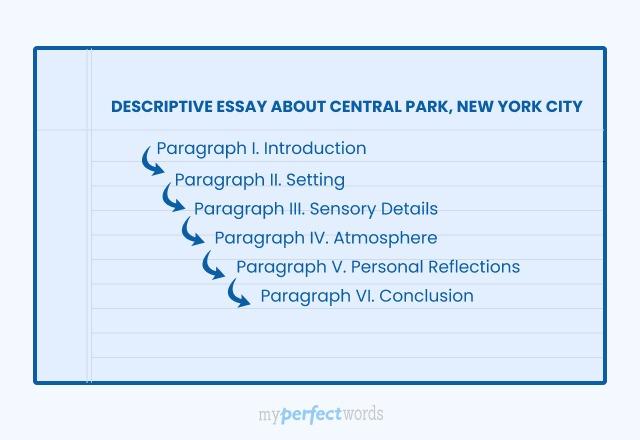
People also read
Descriptive Essay - A Complete Guide
Descriptive Essay Examples & Writing Tips
Top 250+ Descriptive Essay Topics & Ideas
Creating a Descriptive Essay Outline - Format & Example
Crafting an Authentic Portrait: A Guide to Writing a Descriptive Essay About a Person
Writing a Descriptive Essay About Myself - Tips and Tricks
How to Craft the Perfect Descriptive Essay About A Person You Admire
Descriptive Essay About My Mother - A Guide to Writing
Delicious Descriptions: A Guide to Writing a Descriptive Essay About Food
Write A Descriptive Essay About Nature With This Guide
Learn Tips to Write a Descriptive Essay About Autumn - Step into the Golden Season
Are you writing an essay about a place and need to know where to start?
The beauty of the world lies in its diversity, and every place has something unique to offer. A descriptive essay can bring these places alive for readers. But the question is, how do you write one?
Don't worry! We've got the right answer for you!
With a few examples and some tips on crafting your own essay, you can write it easily.
So read on to find good samples and tips to follow!
- 1. Understanding Descriptive Essays
- 2. Examples of Descriptive Essay About Any Place
- 3. Tips for Writing an Excellent Descriptive Essay About A Place
Understanding Descriptive Essays
A descriptive essay is a type of writing that aims to describe and portray an object, person, or place. The essay typically includes sensory details to help the reader imagine its contents more vividly. Descriptive essays can be written about a person , place, or other themes like nature , autumn , food , or even yourself .
A descriptive essay about a place should provide enough details for the reader to build a mental image of it. To do this, you need to include vivid descriptions and relevant information that could paint a picture in their minds.
Let's read some examples to see what a good descriptive essay looks like.
Examples of Descriptive Essay About Any Place
Here are some descriptive writing about a place examples:
Example of a Descriptive Essay About a Place
Descriptive Essay About a Place You Visited
Descriptive Essay About a Place Called Home
Descriptive Essay About a Place You Loved as a Child
Descriptive Essay About a Place of Interest I Visited
Descriptive Essay About a Favorite Place
Do you need more sample essays? Check out more descriptive essay examples t o get inspired.
Tips for Writing an Excellent Descriptive Essay About A Place
Now that you've read some examples of descriptive essays about places, it's time to learn how to write one yourself. Here are some tips on writing a great essay:
Choose The Right Topic
The topic of your essay should be something that you have a strong connection to or feeling about. It could be a place you've visited recently or a place from your childhood. Moreover, make sure that it's something that you can write about in enough detail to make your essay interesting.
Check out this blog with 100+ descriptive essay topics to get your creative juices flowing.
Gather Information
Gather as much information as possible about the topic of your essay. This will help you craft vivid descriptions and portray an accurate picture for your readers. Gather your observations, research online, and talk to people who have visited the place you're writing about.
Make sure to research the topic thoroughly so you can provide accurate and detailed descriptions. Read up as much as you can about the history of the place, and any interesting facts or stories about it.
Structure Your Essay
Outline your descriptive essay before beginning to write so all points flow logically from one to another throughout the entire piece.
Make sure to include a strong introduction and conclusion, as well as several body paragraphs that help support your main points.
Include Sensory Details
Use sensory language by including details such as sights, smells, tastes, sounds, etc. This helps to engage readers and transport them into the setting of your essay.
When writing a descriptive essay, make sure to include vivid descriptions that involve all five senses. This will help create a more engaging and immersive experience for your readers.
Use Vivid Language
Make sure to use strong and powerful words when describing the place you're writing about. Use metaphors and similes to bring your descriptions to life and make them more interesting for readers.
Proofread Your Essay
Proofreading is an important step in any writing process, especially when it comes to descriptive essays. Make sure to check for any typos or spelling errors that may have slipped through in your writing.
You also need to make sure that the flow of your essay is logical and coherent. Check if you've used a consistent point of view throughout, and make sure that all ideas are well-supported with evidence.
Follow these tips and examples, and you'll be well on your way to writing a great descriptive essay.
Don't stress if you still want a professional writer to do it for you. We've got the best solution for you.
MyPerfectWords.com offers the best custom essay writing service to help you write a great descriptive essay. Our experienced writers are here to provide high-quality and error-free work to help you get the grade you deserve. With our essay writing service, you are guaranteed a 100% original essay.
Get in touch with us to hire our descriptive essay writing service now.

Write Essay Within 60 Seconds!

Caleb S. has been providing writing services for over five years and has a Masters degree from Oxford University. He is an expert in his craft and takes great pride in helping students achieve their academic goals. Caleb is a dedicated professional who always puts his clients first.

Paper Due? Why Suffer? That’s our Job!
Keep reading
-10240.jpg&w=828&q=75)

IMAGES
VIDEO
COMMENTS
Examples of Descriptive Essays About a Person - Descriptive essay is one type of essay that aims to describe a specific object (animal, person, or other thing) specifically. This text type has a slight difference with report text written based on common terms. The following essays are some examples of descriptive essays about a person, family members, and famous people.
1. Brainstorm Your Ideas. Brainstorming is crucial to any writing process. It's the process in which you think of ideas for what you'd like to write about. In this case, you're writing a descriptive paragraph about a person. It's important to use adjectives to describe the features or characteristics you want to focus on.
A descriptive essay relies on facts and information to describe a subject as it is. A descriptive essay about a person is often written to describe a particular person. It can be about a person you admire, an acquaintance, family member like mother, friend, or even a celebrity. Here are some examples to give you a better idea.
The Basics of Descriptive Essay. A descriptive essay is an essay that requires the student to provide a detailed and precise description of their chosen subject.. When writing about a person, the goal is to introduce your reader to the person you are writing about. You will want to include important facts about them and discuss their personality, including their beliefs, hobbies, and interests ...
3. Write a Thesis Statement. It is the most important part of any essay. When you are planning a descriptive essay, you need to come up with a strong thesis statement. A thesis statement is usually one or two sentences that explain the whole point of your essay to the reader. 4.
Like every essay sample, a descriptive essay has an outline and format. The essay follows the traditional essay structure and includes: 1. An Introductory Paragraph. The first paragraph of an essay is the introduction and it usually sets the mood for the entire essay. A good descriptive essay has a strong opening.
As the author, you will be required to convey the physical and, more importantly, the emotional attributes of the person or the place you are describing. To grab your reader's attention for your essay, your descriptions have to be interesting. But don't forget about the structure of the essay itself. It is crucial that it has a captivating ...
Brainstorm Descriptive Details: Before you start writing, make a list of physical attributes, personality traits, habits, and mannerisms that characterize the person. Think about specific anecdotes or memories that showcase their unique qualities. Create an Outline: Organize your essay with a clear structure, including an introduction, body ...
Tips for writing descriptively. The key to writing an effective descriptive essay is to find ways of bringing your subject to life for the reader. You're not limited to providing a literal description as you would be in more formal essay types. Make use of figurative language, sensory details, and strong word choices to create a memorable ...
The use of literary devices such as personification and metaphor makes the banyan tree in the second example come to life. This is how you can make your writing more vivid, descriptive, and poetic. 2. Use your senses. Sensory descriptors are one of the most important aspects of a descriptive essay.
Descriptive essays breathe life into words by painting a vivid picture of a person, place, thing, or experience. They employ sensory details and expressive language to make the subject come alive for the reader. Here's a basic yet effective structure you might use when crafting a descriptive essay: 1. Introduction.
A descriptive essay is a type of essay that involves describing a person, object, or any type of noun. We guide you through writing one with examples. ... Sample Body Paragraph for a Descriptive Essay. Unlike with other essay forms, you do not have to worry about providing evidence. You obviously can if you think it'll help you with your ...
6. Find descriptive adjectives and fitting comparisons. There are two useful tools for accurate description of characters in stories: Precise, exact adjectives, and comparative language. Finding adjectives to describe people with positive and negative connotations. Positive adjectives to describe a person include:
Descriptive Essay Example About A Person. Descriptive essays are the best option when it comes to describing and writing about a person. A descriptive essay is written using the five human senses. It helps in creating a vivid image in the readerâ s mind and understanding what the writer is trying to convey. Here is one of the best descriptive ...
Descriptive Essay about a Person. This essay sample was donated by a student to help the academic community. Papers provided by EduBirdie writers usually outdo students' samples. My friend Matthew Ross is a big part of my life, I met him in high school, and ever since we have been best friends.
The purpose of this essay is quite clear: you have to express your feelings about a particular subject or object and describe its significant features. In most cases, students are forced to describe events, places, objects, and people. The last type is probably the most difficult because the description of a person won't include the appearance only, but would also consider character ...
A descriptive essay is a type of writing that aims to vividly describe a person, place, object, or event. In this type of essay, the writer uses sensory details such as sight, sound, smell, taste, and touch to create a clear and vivid image in the reader's mind. The goal of a descriptive essay is to evoke a strong emotional response or create ...
3. Describe the Person. Now, this is the harder part. But, if you've brainstormed plenty of ideas and know which ones you want to emphasis set, it will become easier. Let's look at some real to getting a better idea by how to write a descriptive paragraph about a person using the call "describe a person you admire." Show 1:
A Descriptive Essay is a genre of essay writing that allows a writer to provide a vivid description of something- a person, an event, a place, a personal experience, an object, an emotion, etc. . Descriptive essays, like narrative essays, tend to allow the writer a great deal of artistic freedom than most academic writings. Good descriptive essays examples include newspaper articles, research ...
Psychology essay example page will help as well. The three biggest tips for writing descriptive essays are to use a person you know, bear in mind that actions speak louder than words, and make the most of the personality traits. 1. Use a Person You Know. Using a person you know can build a foundation for descriptions.
Appearance is what someone looks like on the outside. Mannerisms are the ways that someone acts or behaves. Character traits are the little things that make someone who they are. In other words, they make up someone's personality. Emotions are what someone feels at a certain time.
Describing a person is a fun and easy way to start practising the descriptive writing process. When describing a person, children should try to build a full picture by using descriptive language. Twinkl tips: Think about the 5 senses - see, hear, touch, smell, taste. Use descriptive language such as metaphors and similes to paint a visual ...
A descriptive essay is a type of writing that aims to describe and portray an object, person, or place. The essay typically includes sensory details to help the reader imagine its contents more vividly. Descriptive essays can be written about a person, place, or other themes like nature, autumn, food, or even yourself.
When applying to college, your essay should provide insight into your personality, interests, and goals. Descriptive adjectives can be a powerful tool when writing a memorable personal essay. Here are some examples of how you can describe yourself on a college application using descriptive adjectives: